Or try one of the following: 詹姆斯.com, adult swim, Afterdawn, Ajaxian, Andy Budd, Ask a Ninja, AtomEnabled.org, BBC News, BBC Arabic, BBC China, BBC Russia, Brent Simmons, Channel Frederator, CNN, Digg, Diggnation, Flickr, Google News, Google Video, Harvard Law, Hebrew Language, InfoWorld, iTunes, Japanese Language, Korean Language, mir.aculo.us, Movie Trailers, Newspond, Nick Bradbury, OK/Cancel, OS News, Phil Ringnalda, Photoshop Videocast, reddit, Romanian Language, Russian Language, Ryan Parman, Traditional Chinese Language, Technorati, Tim Bray, TUAW, TVgasm, UNEASYsilence, Web 2.0 Show, Windows Vista Blog, XKCD, Yahoo! News, You Tube, Zeldman
ongoing by Tim Bray
ongoing fragmented essay by Tim BrayHumanist Plumbing 18 Dec 2025, 8:00 pm
What happened was, a faucet started dripping. And then I managed to route around the malignant machineries of late-stage capitalism. These days, that’s almost always a story worth telling.
Normally, faced with a drip, we’d pull out the old cartridge, take it to the hardware store, and buy another to swap in. But the fixture in our recently-acquired place was kind of exotic and abstract and neither of us could figure it out. We were gloomy because we’ve had terrible luck over the years with the local plumbing storefronts. So…
The neighbors
Our neighborhood has an online chat; both sides of the streets in a square around a single city block. This is our first experience with such a thing. I gather that these don’t always work out well, but this one has been mostly pretty great.
So at 9AM I posted “Hey folks, looking for a plumber recommendation” and by ten there were three.
[Late-stage capital: “You’re supposed to ask the AI in your browser. It’ll provide a handy link to a vendor based on geography and reviews but mostly advertising spend. Why would you want to talk to other people?”]
Thomas
I picked a neighbor’s suggestion, first name Thomas, and called the number. “Thomas here” on the second ring. I explained and he said “What’s the brand name? If it’s one of those Chinese no-names I probably have to replace the whole thing.” I said “No idea, but I’ll take a picture and send it to you.”
Turns out the brand was Riobel, never heard of them. I texted Thomas a picture and he got right back to me: “That’s high-end, it’s got a lifetime warranty. I’ll come by a little after 5 and take it out. Their dealer is in PoCo (an outer suburb) and I live out there, so I can swap it.”
[Late-stage capital: “You’re supposed to engage with the chatbot on the site we sent you to, which will integrate with your calendar and arrange for a diagnostic visit a week from Wednesday. You could call them but you’d be in voice-menu hell and eventually end up at the same chatbot.”]
When Thomas showed up, with a sidekick, he was affable and obviously competent. Within five minutes I was glad I’d called for help; that faucet’s construction was highly non-obvious. Thomas knew what he was doing and it still took him the best part of a half-hour to get it all disassembled and the cartridge extracted.
Nothing’s perfect
The next morning, a text from Thomas: “Bad news. That part is back-ordered till May at Riobel’s dealer. We can maybe get it online but you’d have to pay.” He attached a screenie of a Web search for the part number; there were several online vendors.
It’s irritating that the “lifetime warranty” doesn’t seem to be helping me, but to be fair, the part was initially installed in 2011.
[Late-stage capital: “Lifetime warranty? Huh? Oh, of course you mean our VIP-class subscription offering, that’s monthly with a discount for annual up-front payment.” (And the part would still be back-ordered.)]
Kolani
High-end plumbing parts are expensive. But one of Thomas’ recommendations, Kolani Kitchen and bath, was asking less.
They had a phone number on their Web site so I called it and the voice menu only had three options: Location, opening hours, and Operator. The operator was an intelligent human and picked up right away. “Hi, I’m looking at ordering a cartridge and wanted to see if you had it in stock.” “Gimme the part number?” I did and she went away for a couple of minutes and came back “Yeah, it’s in stock.” So I ordered it and I have a tracking number.
[Late-stage capital: “There aren’t supposed to be independent dealers; the manufacturer has taken PE money and eliminated the middlemen to better capture all the value-add. Or maybe there’ll be a wholesaler, but just one, because another PE rolled up all the distributors to maximize pricing power. Either way, you won’t be able to get a human on the line.”]
Payment
Next morning, I got an email that my order had been canceled. So I called that intelligent operator and she said “I was going to email you. Our system won’t take payment if the billing and delivery addresses are different. Sorry. If you’re in a hurry you could do an e-transfer?” (In Canada, all the banks are in a payments federation that makes this dead easy.) So I did and the part has shipped.
[Late-stage capital: “What? If you’d used our Integrated online payment offering, it would all just work. What if it doesn’t, you ask? Yeah, sucks to be you in that situation, of course there’d be nobody you could talk to about that.”]
Thomas came by again to put the old cartridge back in for now and said “This thing, don’t worry about a drip, it’s not fast and it probably won’t get worse. Text me when the new part gets in.”
Late-stage capitalism
It won’t be missed when it’s gone.
After the Bubble 7 Dec 2025, 8:00 pm
The GenAI bubble is going to pop. Everyone knows that. To me, the urgent and interesting questions are how widespread the damage will be and what the hangover will feel like. On that basis, I was going to post a link on Mastodon to Paul Krugman’s Talking With Paul Kedrosky. It’s great, but while I was reading it I thought “This is going to be Greek to people who haven’t been watching the bubble details.” So consider this a preface to the Krugman-Kedrosky piece. If you already know about the GPU-fragility and SPV-voodoo issues, just skip this and go read that.
Depreciation
When companies buy expensive stuff, for accounting purposes they pretend they haven’t spent the money; instead they “depreciate” it over a few years. That is to say, if you spent a million bucks on a piece of gear and decided to depreciate it over four years, your annual financials would show four annual charges of $250K. Management gets to pick your depreciation period, which provides a major opening for creative accounting when the boss wants to make things look better or worse than they are.
Even when you’re perfectly honest it can be hard to choose a fair figure. I can remember one of the big cloud vendors announcing they were going to change their fleet depreciation from three to four years and that having an impact on their share price.
Depreciation is orderly whether or not it matches reality: anyone who runs a data center can tell you about racks with 20 systems in them that have been running fine since 2012. Still, orderly is good.
In the world of LLMs, depreciation is different. When you’re doing huge model-building tasks, you’re running those expensive GPUs flat out and red hot for days on end. Apparently they don’t like that, and flame out way more often than conventional computer equipment. Nobody who is doing this is willing to come clean with hard numbers but there are data points, for example from Meta and (very unofficially) Google.
So GPUs are apparently fragile. And they are expensive to run because they require huge amounts of electricity. More, in fact, than we currently have, which is why electrical bills are spiking here and there around the world.
Why does this matter? Because when the 19th-century railway bubble burst, we were left with railways. When the early-electrification bubble burst, we were left with the grid. And when the dot-com bubble burst, we were left with a lot of valuable infrastructure whose cost was sunk, in particular dark fibre. The AI bubble? Not so much; What with GPU burnout and power charges, the infrastructure is going to be expensive to keep running, not something that new classes of application can pick up and use on the cheap.
Which suggests that the post-bubble hangover will have few bright spots.
SPVs
This is a set of purely financial issues but I think they’re at the center of the story.
It’s like this. The Big-Tech giants are insanely profitable but they don’t have enough money lying around to build the hundreds of billions of dollars worth of data centers the AI prophets say we’re going to need. Which shouldn’t be a problem; investors would line up to lend them as much as they want, because they’re pretty sure they’re going to get it back, plus interest.
But apparently they don’t want to borrow the money and have the debts on their balance sheet. So they’re setting up “Special Purpose Vehicles”, synthetic companies that are going to build and own the data centers; the Big Techs promise to pay to use them, whether or not genAI pans out and whether or not the data centers become operational. Somehow, this doesn’t count as “debt”.
The financial voodoo runs deep here. I recommend Matt Levine’s Coffee pod financing and the Financial Times’ A closer look at the record-smashing ‘Hyperion’ corporate bond sale. Levine’s explanation has less jargon and is hilarious; the FT is more technical but still likely to provoke horrified eye-rolls.
If you think there’s a distinct odor of 2008 around all this, you’d be right.
If the genAI fanpholks are right, all the debt-only-don’t-call-it-that will be covered by profits and everyone can sleep sound. Only it won’t. Thus, either the debts will apply a meat-axe to Big Tech profits, or (like 2008) somehow they won’t be paid back. If whoever’s going to bite the dust is “too big to fail”, the money has to come from… somewhere? Taxpayers? Pension funds? Insurance companies?
Paul K and Paul K
I think I’ve set that piece up enough now. It points out a few other issues that I think people should care about. I have one criticism: They argue that genAI won’t produce sufficient revenue from consumers to pay back the current investment frenzy. I mean, they’re right, it won’t, but that’s not what the investors are buying. They’re buying the promise, not of more revenue, but of higher profits that happen when tens of millions of knowledge workers are replaced by (presumably-cheaper) genAI.
I wonder who, after the loss of those tens of millions of high-paid jobs, are going to be the consumers who’ll buy the goods that’ll drive the profits that’ll pay back the investors. But that problem is kind of intrinsic to Late-stage Capitalism.
Anyhow, there will be a crash and a hangover. I think the people telling us that genAI is the future and we must pay it fealty richly deserve their impending financial wipe-out. But still, I hope the hangover is less terrible than I think it will be.
Tracy Numbers 2 Dec 2025, 8:00 pm
Here’s a story about African rhythms and cancer and combinatorics. It starts a few years ago when I was taking a class in Afro-Cuban rhythms from Russell Shumsky, with whom I’ve studied West-African drumming for many years. Among the basics of Afro-Cuban are the Bell Patterns, which come straight out of Africa. The most basic is the “Standard Pattern”, commonly accompanying 12/8music. “12/8” means there are four clusters of three notes and you can count it “one-two-three two-two-three three-two-three four-two-three”. It feels like it’s in four, particularly when played fast.
Here’s the standard bell pattern in music notation. Instead of one 12/8 bar, I’ve broken it into four 3/8 chunks. Let’s call those “mini-measures”; I’ll use that or just “minis” in the rest of this piece.

Bell patterns are never played in isolation, but circularly on fast repeat, so the first note immediately follows the last.
In the sound sample, I’m playing a background beat on a conga, emphasizing the beginning of the 12/8 measures. The actual bell pattern is on the high “child” bell of a Gankoqui, an African dual-cowbell set.

“þ” the cat was trying bell patterns but
unfortunately
cats can’t count as high as 12. Collar by
BirdsBeSafe.com.
That’s my Gankoqui. I bought it off someone on Etsy who imports them from Ghana. It came with that little thin stick that sounds nice, but sometimes I use a regular drumstick when things get loud.
The problem
Russell’s a good teacher and the standard pattern isn’t that tricky, but I just couldn’t get a grip on it. It’s a little harder than it looks what with cycling it really fast, and then you’re playing it against complicated music with other instrumental voices. I probably would have got there, but the lessons ran out of gas in the depths of Covid.
Introducing Tracy
She was Russell’s long-time partner, a good person and good drummer too. When you were struggling with a complex rhythm it was helpful to watch Tracy’s hands, because she was always on the beat.
Tracy lived with stage four metastatic cancer for many years and braved endless awful rounds of therapy while remaining generally cheerful. She could be morbidly funny; I bought her congas (you can hear one behind the beat in the samples) when she had a storage-space problem. She told me she was carefully planning her finances so she’d run out of money just before the cancer got her.
I always enjoyed any time I spent with her. Then, a dozen years into her cancer journey, this last summer it got into her brain and it was pretty clear her end times were upon her.
The hospice
Tracy’s last months were spent at St. John Hospice in Vancouver’s far west. I can’t say enough good things about it. If you’re near Vancouver and your death becomes imminent, try to be there if you can’t be at home. It’s comfortable and the staff are expert and infinitely kind. The rules that apply at hospices are different from those at hospitals; for example, Tracy’s cat joined her in residency and had the run of the place.
I (and other fans of Russell and Tracy) visited the hospice a few times. My last visit was just days before her death and, while she was fatigued and spaced-out, it was still Tracy. I wasn’t close enough to call her a friend, but I miss her.
We got to talking about Afro-Cuban music and I laughed at myself, saying how I never could get that damn bell pattern down. Said Russell: “Oh, you mean the standard 12/8 pattern? Tracy, let’s show him” and on the second try, they were doing it together, just voices, ta ta ta-ta, ta ta ta.
Driving home from the hospice, I told myself that if Tracy could manage the bell pattern in her condition, I could bloody well learn it. So I studied the details and used a metronome app and after a while I thought I had it down pretty well.
Sounds cool
I go to a weekly by-invitation African drum jam where I’m on the weaker end of the skill spectrum. The first time a 12/8 came along after I thought I’d learned the pattern, I had to summon up courage and then I fluffed the first few bars. But after a while I was grooving along and smiling and thinking the bell sounded pretty cool against the thunder of all the djembés and dununs.
And, even played amateurishly, it does sound cool. Let’s have another look at the music.

West-African drumming often tries to achieve rhythmic tension, where a given note could fit in multiple ways and your ear is not 100% sure what’s going on. The standard pattern does this, twice.
Remember, I said that 12/8 sounds like it’s “in four”, especially if you hit the first beat of each of the four mini-measures. But two of the four minis here go around the first note, weakening the 4/4 feel. Especially on that third mini; you can feel the beat slide by the missing “one”.
Also, the last three notes are evenly spaced two beats apart, so six of them would fill the 12-beat pattern, suggesting that this might be in triple time, not 12/8.
The effect, to my ears, is of the bell, higher-pitched than the drums, shifting against the rhythm, or even dancing across it. At the drum jam, at almost any given moment it won’t be just drums, one or more people will have clave sticks or rattles or tambourines or cowbells weaving through the beat.
Mixing it up
After I felt confident playing the standard pattern, it still sounded cool, but I wanted to branch out, not just go around and around the same seven notes. So the first thing I did was start mixing in a few of these.

This repeats the second bar through the end of the phrase. In the sound sample I mix it up with the standard pattern. It’s got less rhythmic tension but on the other hand flows along smoothly with the drum thunder. Also you don’t have to think at all, so you can enjoy listening to what the other people are playing.
Then I got a little more ambitious and reshuffled:

The mini-measures are the same as in the standard pattern, just in a different order. Anyhow, this kind of thing is fun.
Combinatorics
Then one evening I was lying in bed, thoughts wandering, and wondered “How many bell patterns are there?” A little mental math showed that of course there are eight possible arrangements of tones in a 3-note mini-measure. Here they are:

I’ll use the boxed numbers to identify the minis.
Why are the minis numbered in that order? Every computer programmer looking at this already knows, but for the rest of you: If the notes are ones and the rests are zeroes, they are the eight binary numbers between zero and seven inclusive. So each number’s binary bits show where the drumstrokes are. By the way, numbers four through seven have a note on the one beat, zero through three don’t.
Is it weird to have a zero i.e. silent mini? I don’t think so, sometimes spaces between the notes really matter.
Patterns
Anyhow, the original question was about the number of different bell patterns. Each has four mini-measures with 8 possible values. So the answer is 8 ⨉ 8 ⨉ 8 ⨉ 8, which is 4,096.
And each of them can be identified by four little numbers, ranging from T0000 (I can hear the bandleader yelling “gimme zeroes for the sax break”) to T7777, a flurry of eighth notes that you might use in the big encore-number finish designed to leave the audience yelling as you walk off stage. The standard bell pattern is T5325; in binary “101 011 010 101” and the 1’s are drumstrokes. The first variation above is T5333 and the second is T5253.
The “T” in front of each bell pattern number is for Tracy.
If you go look at the Wikipedia Bell-pattern article, they emphasize that there are lots of different patterns. Now they all have numbers! The article makes special mention of T5124, T5221, and T5244.
But why, Tim?!
I’m a computer programmer with a Math degree, and an amateur musician. Anyone who thinks that these are disjoint disciplines is wrong. And, I think the notation is (on a very small scale) kind of pleasing.
But the work has actually helped me. Now that I’ve considered each mini-measure and its personality. I find all of them sneaking into my Gankoqui excursions, which have gotten noticeably weirder, for example T5635. Nobody’s threatened to kick me out of the jam, so far.
Also, this has given me a real appreciation of whoever it was that, probably thousands of years ago and certainly in Africa, picked the “standard” pattern as, well, standard. Because it’s great.
What’s missing?
You may have noticed that Gankoquis have two bells and I’ve been ignoring that fact. Normally you’d play these patterns on the smaller “child” bell, but sometimes bringing the big parent bell in for a couple of strokes works well. Here’s an example (h/t Russell).
Also, this discussion has been limited to 3/8 minis in 12/8 measures. There’s another whole universe of 4/4 rhythms that also have bell patterns (but everything exists in the shadow of the clave rhythm). In that world a pattern has four measures, each of which can have sixteen possible values, so there are 65,536 different ones.
And I could repeat the numbers construction above for 4/4. But I’m not going to, because the rewards feel smaller. In my experience, 4/4 rhythms lope smoothly along and everyone knows where the one is even when there’s no note on it, so there’s less ambiguity to work with. Anyhow, any neophyte (like for example me) can play a pretty smooth bell line against 4/4; just start with clave and add variations (or don’t) and you’ll be fine.
Useful?
These numbers are just elementary mathemusical fun. If anyone else wanted to use them that’d be a pleasant surprise. If “anyone else” is you, go ahead, but they have a name and you have to use it. These are called Tracy Numbers.
Colophon
Music fragments by MuseScore Studio. Sound samples facilitated by GarageBand, a Shure MV51, and PSB Alphas.
Fútbol Joy 23 Nov 2025, 8:00 pm
Last Saturday I had one of my peak 2025 experiences, at the MLS semifinal between the Vancouver Whitecaps FC (hereinafter “Caps”) and Los Angeles FC (“LAFC”). Both those FC’s stand for “Fútbol Club”. 53,095 other fans were there with my son and I; we came home smiling. I’d like to share a bit of the joy and an unexpected side-effect: I’ve gone off most other TV sports.
Earlier this year I wrote about becoming a Caps fan. Anyone who enjoys this will probably like that piece too.
Let’s set the scene with pictures.

Supporters gather pre-game at a nearby Irish-flavored pub.

Supporters march to the game.
When you’re in a frivolous parade, everyone smiles
at
you, even the drivers hemmed in by paraders.

The banner is what’s called a
tifo.
I have to admit I failed to parse it.
The game
It was 120 minutes of ridiculously over-the-top psychodrama. I was exhausted at the end. If you want a full retrospective, type “whitecaps lafc” into any Web search to get the particulars. Or hit this. But here’s the short version:
The Caps came out sharp and fast and had LAFC pretty well flummoxed through most of the first half, scoring two goals, one of which was a jaw-dropper. They also managed to contain LAFC’s superstar Son Heung-min.
In the second half, the visitors reconfigured and were much better. Son did the superstar thing and scored two goals, one another jaw-dropper, just as the game was ending, to tie things up.
The Caps lost two players, one for fouls, one to injury, and were down two men through most of overtime. LAFC’s assault was relentless but the Caps held on, getting more than a little lucky.
So it went to a penalty-kick competition. Son, shockingly, missed; he was exhausted and limping. At the end of the day the Caps scored four out of five to LAFC’s three and got the win.
Suffice it to say that the dramatic peak wasn’t any of the flashes of brilliance, but rather the errors that happen when people are at the limit of their endurance. Vancouver made one fewer, that’s all there was to it.
That sound
There’s not another like it on this planet. I mean tens of thousands of voices in a big stadium greeting a home goal. Fútbol specifically because its goals, compared to North American sports where points come in dozens, are such huge markers. The sound-pressure wavefront, coming from every direction, of all those inarticulate howls of joy, all in the same tiny fraction of a second, is a whole-body experience.
The side effect
I’ve long been a televised-sports fan; the only TV show that isn’t scripted and thus has real drama. But since getting mixed up in fútbol, I’ve sort of gone off the other sports I used to watch. I had to think a bit to figure out why.
It’s the ads. The football, basketball and hockey broadcasts screech to a halt every ten or fewer minutes for a couple of minutes of advertising. Most of the ads are dumb, many are offensive, and the relentless addiction-promoting gambling pitches are both. On top of which there’s the bone-headed repetition; someone somewhere thinks I’m gonna lean toward this generic SUV as opposed to that one because of the 138th time they’ve run that commercial where hip young people with fulfilling lives are going to have sex because of its dashboard geometry and motorized hatchback. I mean, the other SUVs have that stuff too, but this one’s actors are more convincingly likely to be headed for bed?
Being in the room with this shit makes me angry even though my mute-button skillz are sharp. The world being what it is, I really don’t need to be around something that angers me several times per hour. So, while when young I loved playing both football and basketball, and while the pro games are good entertainment, my patience seems to be running out.
Fútbol, on the other hand, has two fiftyish-minute chunks of continuous action, so you can sink into the flow of the game. The contrast, switching back and forth between that and the other North American sports, is stark.
(Except for I’m mostly forgiving baseball because its natural rhythm is full of stops suitable for hot dogs and beer and admiring cute babies and T-shirts and discussions of etymology and epidemiology. I mean, the ads are still mindless repetitive shit, we’re just more accustomed to switching attention away when nothing’s happening.)
And I’m not claiming that fútbol is more virtuous or less dirty than any other sport; after all, its global organizing body FIFA has repeatedly been exposed as galactically corrupt. I’m just saying it offers a better experience.
Soccer?
That word is an awkward invention by nineteenth-century British toffs based on abbreviating “association”. I accept that on my continent “football” means gridiron, but people who enjoy “soccer” still say it so in print I offer “fútbol”, which is a typographically nice little cluster; please humor me.
Anyhow, you might want to check out your local team; in North America, the prices are lower than the other sports, who could be against cheap happiness with fewer gambling ads?
Long Links 16 Nov 2025, 8:00 pm
As usual, offering more long-form stuff here than any one person should be expected to read all of, hoping that a few of the choices will improve your day. This time out it’s almost all politics, but that’s the way the world is. And some of the politics aren’t American!
Some of these are paywalled, sorry. And the whole thing is kind of long so if you’re in a hurry, you might want to jump to the last section, entitled Wonderful things.
Social media
Here’s a real treat. Perhaps the premiere example of a blog that’s grown happily from a one-man operation to a successful and sustainable small business would be Talking Points Memo. It provides what I think is about the deepest carefully-reported coverage of the American progressive scene available anywhere. I’ve been a subscriber for years.
They’re celebrating their 25th anniversary and, to celebrate, have been working on a history of blogging: Pivots, Trolls, & Blogrolls. Contributors so far: Sarah Jaffe, Matt Pearce, Brian Beutler, Kylie Cheung, Megan Greenwell, David Weigel, Jon Allsop, Adam Mahoney, Julianne Escobedo Shepherd, Max Rivlin-Nadler, Bhaskar Sunkara, Hamilton Nolan, Ana Marie Cox, Marisa Kabas, Kelly Weill, Aurin Squire, Marcy Wheeler, Andrew Parsons, Jeet Heer, and Sarah Posner.

It’s full of razor-sharp insights and nostalgic smiles. I think it’s paywalled? If so, and if you’ve got feels about the blog form, it’d probably be worth your while to sign up for a month just to read this collection.
And thanks to Josh Marshall of TPM for putting it together all these years and especially for this particular mind candy.
Politics (US)
The Trump administration is, generally speaking, strange. For a terrifying trip several standard deviations off the strange end of the strangeness, there’s Laura Loomer’s Endless Payback. At several points in my traversal of this piece I simply could not believe what I was reading. My guess is that it will regularly be cited by historians of the 23rd century, to add spice to their narrative.
Many commentators on the right have been horrified at Zohran Mamdani’s New York victory, seeing him as the white-hot pointy end of the “woke mind virus”. Well, what could be more woke, I ask, than the Department of Africana Studies at Bowdoin, a boutique liberal-arts college in Maine?
Mamdani was a student there, and now the former head of said department offers us Maybe Don’t Talk to the New York Times About Zohran Mamdani. Peter Coviello is not a moderate but is a formidable writer: “The storied choice between socialism and barbarism was made exquisitely clear a good many years ago in the United States, and both major parties chose barbarism.” Despite that, it’s mostly written with a light touch, often amusing. Read it.
Politics (Other)
It’s not in the news much, but China is facing colossal economic challenges. Learn about “meijuan” (in English, “involution”) which might well put the nation on the path of deflation. That’s a path that, once an economy is on it, is very hard to get off; it took Japan decades.
While we’re looking at China… there used to be “Kremlinology”, a study of the entirely opaque workings of the top inner circles of the Soviet regime. In that spirit, here’s some 人民大会堂-ology: Forever Xi Jinping? Perhaps Not. I enjoyed it but have no idea if it’s, you know, correct. Nobody outside that inner circle does.
Now let’s jump seven time zones west, to France, where the redoubtable Thomas Piketty offers Le Pen’s RN has become the party of billionaires. Unlike the Beijing piece, Piketty’s is (as usual for him) supported by concrete data and I tend to believe it.
Last stop: Gaza, waiting to find out if an externally-imposed and leaky ceasefire will hold, and whether there is a path from where they are to something better. As for “where they are”, here’s The Gaza I Knew Is Gone by Ghada Abdulfattah. It describes life’s experience for the citizens of Gaza after all these endless months of brutality.
Politics (everywhere)
Pope Leo’s Apostolic Exhortation Dilexi Te of the Holy Father Leo XIV To All Christians On Love For The Poor got a short-lived run in the headlines, accompanied by “But that’s… socialism!” pearl-clutching from Stage Right. It deserves a read. The first three-quarters or so are a trip through Church history, starting in Nazareth, aimed at showing that concern for the poor has always been central to the faith. Which is fine, but eventually the Pope gets concrete about the twenty-first century, and is convincing whether or not you believe in any gods.
The next section is about Tech and while Radical CS is a presentation from “The Third NIST Workshop on Block Cipher Modes of Operation” it’s about politics, oh yes it is. We very much need more of this kind of thing.
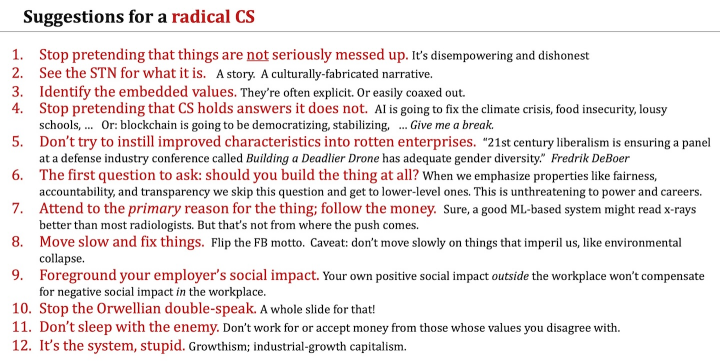
Tech
A post from David Chisnall on Mastodon contains this gem: “Machine learning is amazing if … the value of a correct answer is much higher than the cost of an incorrect answer.” Which is one of those things that’s obviously true as soon as you hear it. The whole piece is good.
The churning debate around AI is full of arm-waving and relatively free of objective numerical data. So here’s Ed Zitron’s This Is How Much Anthropic and Cursor Spend On Amazon Web Services. And I ask: How do the people making these investments think they’re going to get their money back?
Speaking of things are obviously true: TextEdit and the Relief of Simple Software. We could do so much better than we do, and in our hearts we know why we’re not, and it’s about money and power, not technology.
Bluesky has brought its AT Protocol to the IETF; let’s see what happens. Here are Authenticated Transfer: Architecture Overview and Authenticated Transfer Repository and Synchronization. The drafts have source-code repos.
Finally, here’s Spinel, which is trying to build a decentralized, transparent, and somewhat-democratic engineering resource for the Ruby and Rails platforms. This follows on a distinctly-stinky power play where people with money grabbed the steering wheel. Best of luck to Spinel.
Canadian health
Canada has “single-payer” public healthcare that comes with your taxes, which in my experience works well, see here and here.
This costs a lot of money, over $300B/year. Predictably, there are business types panting with eagerness to get their hands on some of that money. And they can; a lot of medical practices and clinics and labs are owned by private companies, apparently doing well while being restricted to billing the government for the standard fees. But what they really want is a two-tier system where they can directly charge rich people more for better care. It seems like every year someone thinks up a clever dodge to nibble away at the system. Fortunately, these people have, so far, ended up losing in the courts.
Here’s a news story: AI Could Save Canada’s Health-Care System. It’s actually pretty coherent and I found it plausible that this technology could maybe improve, for example, the agonizingly slow emergency-room experience.
But then I got curious as to the business angle and tracked the source of the story down to a business called called maple. Sure enough, here they are trying to siphon off direct payments for access to doctors. I predict they’ll end up in court, and lose.
And then there’s the government of Alberta, run by hard-right dipshits who hate most aspects of being Canadian and loathe the proposition that government can provide good and efficient services. Thus: Alberta government plans to allow residents to privately pay for any diagnostic or screening service. Feaugh. I hope this one ends up in court too.
Paying for Open Source
It is coming to the world’s attention that most of our tech infrastructure is radically dependent on open-source software maintenaned by a cadre of developers who are old, tired, and not getting paid for their work. I have direct experience with trying unsuccessfully to convince Big-Tech business leaders to invest in Open-Source maintenance and infrastructure. Here’s some of the coverage:
In The Register: Open source maintainers underpaid, swamped by security, going gray.
Open Source Security Foundation: Open Infrastructure is Not Free: A Joint Statement on Sustainable Stewardship.
Nils Adermann: A Call for Sustainable Open Source Infrastructure.
Hackernoon: How Can Governments Pay Open Source Maintainers?
The New Stack: FFmpeg to Google: Fund Us or Stop Sending Bugs.
Things obviously can’t go on as they are. The best path forward isn’t obvious to me, but we need to start finding it.
Economics and life
Paul Krugman and Martin Wolf, two really smart guys who aren’t technologists, talk about the impact of AI. Technofeudalism is considered carefully. My favorite out-take is from Krugman: “[I] have come to the conclusion that anything that I want to believe about the prospects of AI and its economic effects, all I need to do is do a little searching, and I can find some expert who will tell me whatever it is I want to believe.” Even with that well-justified cynicism, there is deep stuff here.
I read Matt Levine’s newsletter almost every day; not only does it teach you things about how money makes the world go round, it entertains; his glee at some particularly juicy financial swindle or clever arbitrage maneuver will bring a smile to your face. In Money Stuff: Quantum Bond Trading he addresses a deeper question: Does the Finance business actually benefit society? Obviously a subject worthy of attention, and he makes it amusing.
Wonderful things
The dude who wrote Paddling the Darien is clearly crazy, I guess it’d be more polite to say “insanely brave”. Anyhow, I think there are very few people who won’t be astonished at these pictures and stories
I’m not at all sure what A. Inventions, by Jonathan Hoefler, is, actually. The link that I followed said that GenAI image generators were involved. I don’t care.

Alignment Calendars 1584–1811,
from Jonathan Hoefler’s Inventions.
Let’s end with music. Here are two absolutely exquisite song performances, courtesy of YouTube. First, Old Enough by the Raconteurs, Ricky Skaggs, and Ashley Monroe. The interplay of voices and strings is magical. Then Billy Strings wiith his band and string players, doing Gild the Lily. Just a lovely performance of a fine new song.
That’s all, folks, see you next time.
Kendzior Case-Study 13 Nov 2025, 8:00 pm
There was recently a flurry of attention and dismay over Sarah Kendzior having been suspended from Bluesky by its moderation system. Since the state of the art in trust and safety is evolving fast, this is worth a closer look. In particular, Mastodon has a really different approach, so let’s see how the Kendzior drama would have played out there.
Disclosures
I’m a fan of Ms Kendzior, for example check out her recent When I Loved New York; fine writing and incisive politics. I like the Bluesky experience and have warm feelings toward the team there, although my long-term social media bet is on Mastodon.
Back story
Back in early October, the Wall Street Journal published It’s Finally Time to Give Johnny Cash His Due, an appreciation for Johnny’s music that I totally agreed with. In particular I liked its praise for American IV: The Man Comes Around which, recorded while he was more or less on his deathbed, is a masterpiece. It also said that, relative to other rockers, Johnny “can seem deeply uncool”.
Ms Kendzior, who is apparently also a Cash fan and furthermore thinks he’s cool, posted to Bluesky “I want to shoot the author of this article just to watch him die.” Which is pretty funny, because one of Johnny’s most famous lyrics, from Folsom Prison Blues, was “I shot a man in Reno just to watch him die.” (Just so you know: In 1968 Johnny performed the song at a benefit concert for the prisoners at Folsom, and on the live record (which is good), there is a burst of applause from the audience after the “shot a man” lyric. It was apparently added in postproduction.)
Subsequently, per the Bluesky Safety account ”The account owner of @sarahkendzior.bsky.social was suspended for 72 hours for expressing a desire to shoot the author of an article.”
There was an outburst of fury on Bluesky about the sudden vanishing of Ms Kendzior’s account, and the explanation quoted above didn’t seem to reduce the heat much. Since I know nothing about the mechanisms used by Bluesky Safety, I’m not going to dive any deeper into the Bluesky story.
On Mastodon
I do know quite a bit about Mastodon’s trust-and-safety mechanisms, having been a moderator on CoSocial.ca for a couple of years now. So I’m going to walk through how the same story might have unfolded on Mastodon, assuming Ms Kendzior had made the same post about the WSJ article. There are a bunch of forks in this story’s path, where it might have gone one way or another depending on the humans involved.

Reporting
The Mastodon process is very much human-driven. Anyone who saw Ms Kendzior’s post could pull up the per-post menu and hit the “Report” button. I’ve put a sample of what that looks like on the right, assuming someone wanted to report yours truly.
By the way, there are many independent Mastodon clients; some of them have “Report” screens that are way cooler than this. I use Phanpy, which has a hilarious little animation with an animated rubber stamp that leaves a red-ink “Spam” or whatever on the post you’re reporting.
We’ll get into what happens with reports, but here’s the first fork in the road: Would the Kendzior post have been reported? I think there are three categories of people that are interesting. First, Kendzior fans who are hip to Johnny Cash, get the reference, snicker, and move on. Second, followers who think “ouch, that could be misinterpreted”; they might throw a comment onto the post or just maybe report it. Third, Reply Guys who’ll jump at any chance to take a vocal woman down; they’d gleefully report her en masse. There’s no way to predict what would have happened, but it wouldn’t be surprising if there were both categories of report, or either, or none.
Moderating
When you file a report, it goes both to the moderators of your instance and the of instance where it was posted (who oversee the poster’s account). I dug up a 2024 report someone filed against me to give a feeling for what the moderator experience is like.
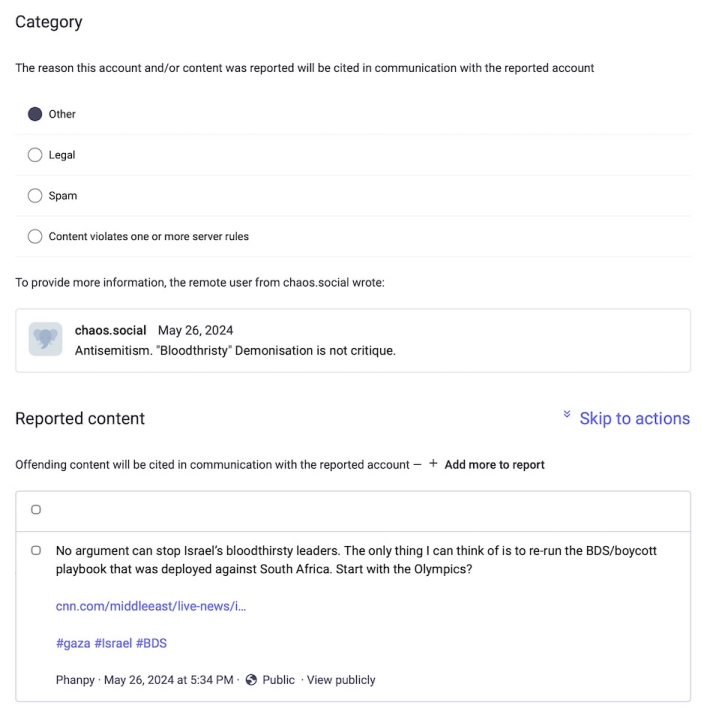
I think it’s reasonably self-explanatory. Note that the account that filed the report is not identified, but that the server it came from is.
A lot of reports are just handled quickly by a single moderator and don’t take much thought: Bitcoin scammer or Bill Gates impersonator or someone with a swastika in their profile? Serious report, treated seriously.
Others require some work. In the moderation screen, just below the part on display above, there’s space for moderators to discuss what to do. (In this particular case they decided that criticism of political leadership wasn’t “antisemitism” and resolved the report with no action.)
In the Kendzior case, what might the moderators have done? The answer, as usual, is “it depends”. If there were just one or two reports and they leaned on terminology like “bitch” and “woke”, quite possibly they would have been dismissed.
If one or more reports were heartfelt expressions of revulsion or trauma at what seemed to be a hideous death threat, the moderators might well have decided to take action. Similarly if the reports were from people who’d got the reference and snickered but then decided that there really should have been a “just kidding” addendum.
Action
Here are the actions a moderator can take.

If you select “Custom”, you get this:
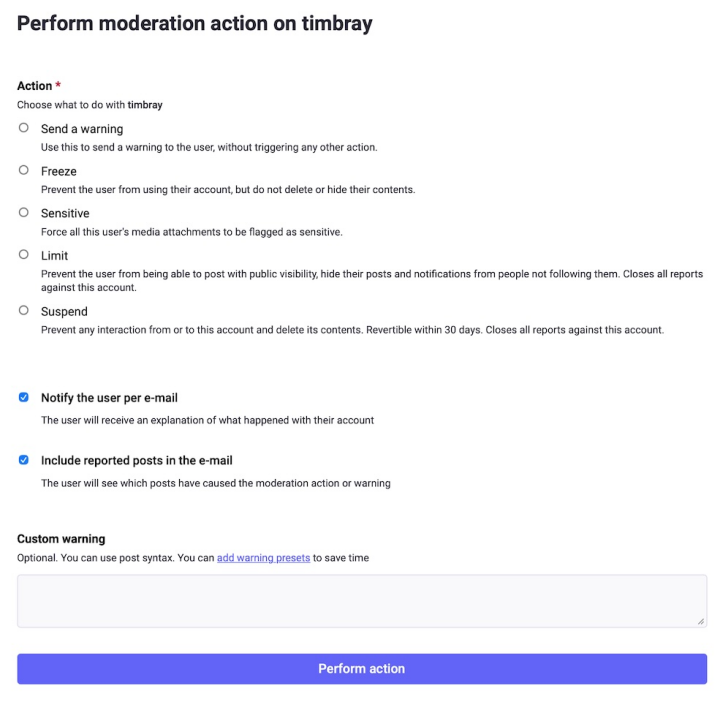
Once again, I think these are self-explanatory. Before taking up the question of what might happen in the Kendzior case, I should grant that moderators are just people, and sometimes they’re the wrong people. There have been servers with a reputation for draconian moderation on posts that are even moderately controversial. They typically haven’t done very well in terms of attracting and retaining members.
OK, what might happen in the Kendzior case? I’m pretty sure there are servers out there where the post would just have been deleted. But my bet is on that “Send a warning” option. Where the warning might go something like “That post of yours really shook up some people who didn’t get the Folsom Prison Blues reference and you should really update it somehow to make it clear you’re not serious.”
Typically, people who get that kind of moderation message take it seriously. If not, the moderator can just delete the post. And if the person makes it clear they’re not going to co-operate, that creates a serious risk that if you let them go on shaking people up, your server could get mass-defederated, which is the death penalty. So (after some discussion) they’d delete the account. Everyone has the right to free speech, but nobody has a right to an audience courtesy of our server.
Bottom line
It is very, very unlikely that in the Mastodon universe, Sarah Kendzior’s account would suddenly have globally vanished. It is quite likely that the shot-a-man post would have been edited appropriately, and possible that it would have just vanished.
Will it scale?
I think the possible outcomes I suggested above are, well, OK. I think the process I’ve described is also OK. The question arises as to whether this will hold together as the Fediverse grows by orders of magnitude.
I think so? People are working hard on moderation tools. I think this could be an area where AI would help, by highlighting possible problems for moderators in the same way that it highlights spots-to-look-at today for radiologists. We’ll see.
There are also a couple of background realities that we should be paying more attention to. First, bad actors tend to cluster on bad servers, simply because non-bad servers take moderation seriously. The defederation scalpel needs to be kept sharp and kept nearby.
Secondly, I’m pretty convinced that the current open-enrollment policy adopted by many servers, where anyone can have an account just by asking for it, will eventually have to be phased out. Even a tiny barrier to entry — a few words on why you want to join or, even better, a small payment — is going to reduce the frequency of troublemakers to an amazing degree.
Take-aways
Well, now you know how moderation works in the Fediverse. You’ll have to make up your own mind about whether you like it.
Time to Migrate 3 Nov 2025, 8:00 pm
Dear World: Now is a good time to get off social media that’s going downhill. Where by “downhill” I mean any combination of “less useful”, “less safe”, or “less fun”. This month marks the third anniversary of my Mastodon migration and I’m convinced that right now, in late 2025, it’s the best place to go. Come join me. Here’s why.
Defining terms
In this post, by “Social media” I mean “what Twitter used to be, back when it was good”. We should expect our social-media future to be at least as useful, safe, and fun as that baseline. (But we can do better!)
By “Mastodon” I mean the many servers, mostly running the Mastodon software, that communicate using the ActivityPub protocol. Now I’ll try to convince you to start using one of them.
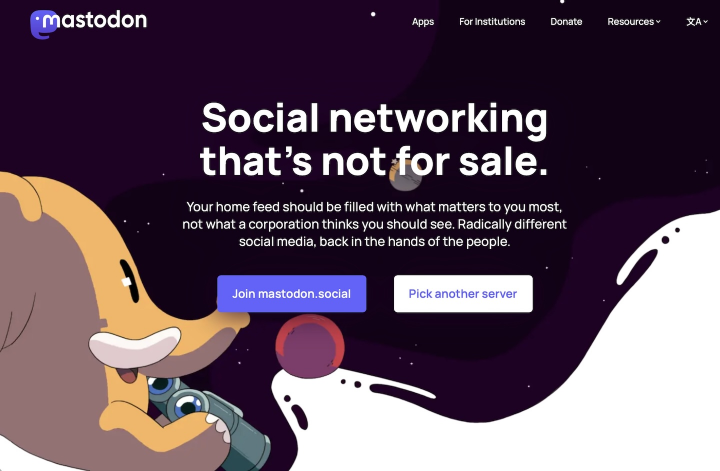
Start at joinmastodon.org
The simplest argument
Have you noticed that social-media products, in the long term, can’t seem to manage to stay fun and safe and useful? I have. But there’s one huge exception, a tool that’s been serving billions of us for decades, and works about as well as it ever did. I’m talking about email.
Why does email stay reasonably healthy? Because nobody owns it. Anyone on any server can communicate with anyone else on any other and it Just Works. Nobody can buy it and make it a vehicle for their politics. Nobody can crank up the ad density or make things worse to improve their profit margin.
Mastodon’s like email that way. Plus it does all the Post and Repost and Quote and Follow and Reply and Like and Block stuff that you’re used to, and there are thousands of servers and anyone can run one and nobody can own the whole thing. It doesn’t have ads and it won’t. It’s dead easy to use and it’s fun and you should give it a try.
The rest of this essay goes into detail about why Mastodon is generally great and specifically better than the alternatives. But if that simple pitch sounded good, stop here, go get an account and climb on board.
Why now?
Two things motivated me to post this piece now. First, this month is my three-year anniversary of bailing out on Twitter in favor of Mastodon.
Second is the release of Mastodon 4.5, which I think closes the last few important-missing-feature gaps.
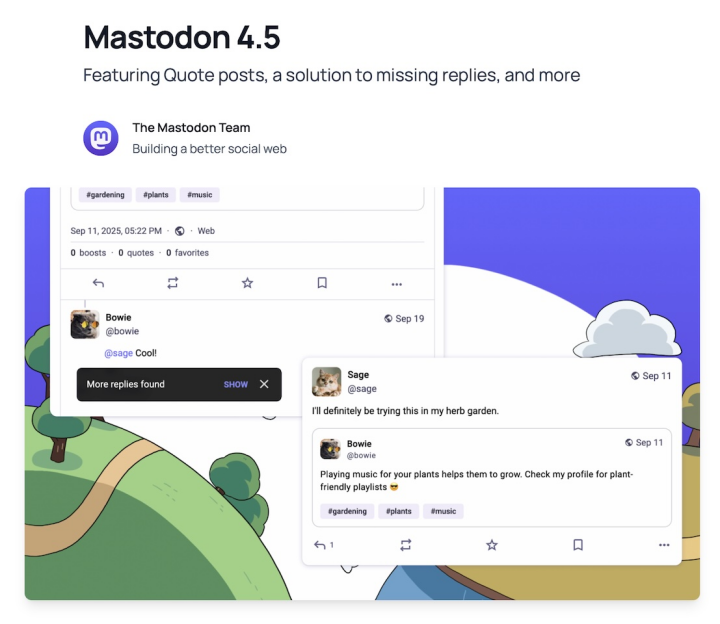
The software is improving rapidly, particularly in the last couple of releases. It’s got cool features you won’t find elsewhere, and there’s very little cool stuff from elsewhere that’s not here. There was a time when newly-arrived people had confusing or unfriendly experiences, or missed features that were important to them. It looks to me like those days are over.
Migration
Mastodon is many thousands of servers, and you can join the biggest, mastodon.social, or shop around for another. But here’s the magic thing: If you end up disliking the server you’re on, or find a better one, you can migrate and take your followers with you! You can’t ever get locked in.

The server-selection menu has lots of options.
This is probably Mastodon’s most important feature. It’s why no billionaire can buy it and no corporation can enshittify it. As far as I know, Mastodon is the first widely-adopted social software ever to offer this.
Interaction
You hear it over and over: “I had <a big number> of followers on Twitter and now I have <a less-big number> on Mastodon, but I get so much more conversation and interaction when I post here.”
One of the people you’ll hear that from is me. My follower count is less than half the 45K I had on Twitter-that-was, but I get immensely more intelligent, friendly interaction than I ever got there. (And then sometimes I get told firmly that I’m wrong about this or that, but hey.) It’s the best social-media experience I’ve ever had.
Dunno about you, but conversation and interaction seem like a big deal to me. One reason things are lively is…
Sex
Here’s an axiom: An ad-supported service can’t have sex-positive or explicit content. Advertisers simply won’t tolerate having their message appear beside NSFW images or Gay-Leatherman tales or exuberant trans-positivity. Mastodon can.
Of course, you gotta be reasonable, posting anything actually illegal will get your ass perma-blocked and your account suspended. So will posting anything that’s NSFW etc without a “Content Warning”. That’s a built-in feature of Mastodon which puts a little warning (“#NSFW” and “#Lewd” are popular) above your post, which is tastefully blurred-out until whoever’s looking at it clicks on “Show content”. I use these all the time when I post about #baseball or #fútbol because a lot of the geeks and greens who follow me are pointedly uninterested in sports.
(Oh, typing that in reminds me that you can subscribe to hashtags on Mastodon: Let’s see, I currently subscribe to, among others, #Vancouver, #Murderbot, and #Fujifilm.)
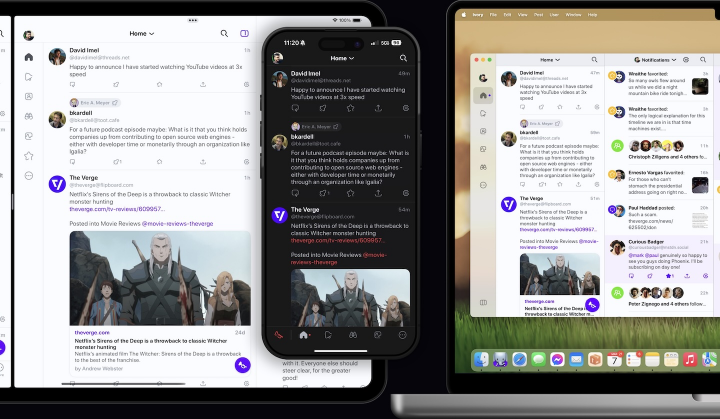
The “Ivory for Mastodon” app for Apple platforms,
one of the many fine alternative clients.
Moderation and defederation
Did I just mention, two paragraphs up, getting blocked? Mastodon isn’t free of griefers, but the tools to fight them are good and getting better.
The good news is that each server moderates its own members. So there’s some variation of the standards from server to server, but less than you’d think. Since there are thousands of servers, there are thousands of moderators, which is a lot.
If you act in a way that others find offensive, you’ll probably get blocked by the offended people and also reported; the report can come from any server and it’ll go to the moderators on yours. On a well-run server, those mods will have a look and if you’ve actually been bad, your post might get yanked and you might get warned, or in an extreme case, booted off.
(I’ve been reported for saying unkind things about Bibi Netanyahu and for posting too many photos of my cats (no, really) but that kind of thing is cheerfully ignored by good moderation teams.)
Then there’s Mastodon’s nuclear weapon: Defederation. Suppose you’re prone to nasty bigotry in public and you get reported a lot and your server’s moderators don’t rein you in. Eventually, word will get around, and if things aren’t cleaned up, most servers will defederate yours, so that nobody on their server can see posts from anyone on yours. Your site is no longer part of the “Fediverse”; this is a powerful incentive for server owners to take moderation seriously.
The effect of all this is that the haters and scammers and Nazis who show up get shuffled off-stage PDQ. Well, almost always; a couple of years ago a wave of incoming Black people had bad experiences with racist abuse. Ouch. But the good news is that recent Mastodon releases have been shutting prone-to-abuse channels down, so things are better than then and should continue to improve.
Links are good
Corporate social-media services like to downrank posts with links. Which makes me want to scream, because my favorite thing to post is a link+reaction to something cool, and my favorite posts to read are too.
On Mastodon, when you have a link in a post, the software automatically fetches a preview of whatever you linked to and uses it to decorate your link. I mean, it’s the damn Internet, it only got interesting to non-geeks when we figured out how to turn millions of servers into a great big honking searchable hypertext.
Search
Speaking of which, Mastodon search is pretty good these days. It’s become, just like this blog, part of my outboard memory, and I’m always typing things like “telephoto from:me has:media” into the search box. Fast enough, too.
Great clients
Another good thing about Mastodon is that there are lots of clients to choose from, mostly open-source. The best ones are miles ahead of Xitter and Threads and Bluesky and, really, anything.
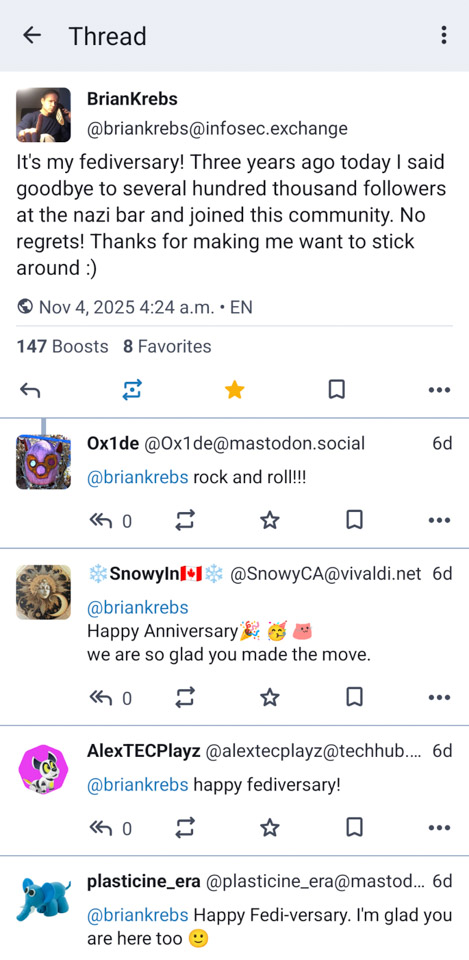
Anniversary post in the Android “Tusky” app.
There are official Web and mobile clients from the Mastodon team and they’re fine, especially for admin and moderation work. But iOS people should check out Ivory, Androiders should look at Tusky, and everyone should try Phanpy. I live in Phanpy on both my Mac and my Pixel — it’s a Web thing but installable as a PWA on both Android and iOS.
Commercial products, especially social-media services, have never been at peace with third-party clients. Twitter used to be, but then it stabbed those developers in the back. It’s easy to understand why; every product manager has it drilled into them that they must control the user experience. This ignores the ancient wisdom (I first heard it from Bill Joy) “Wherever you work, most of the smart people are somewhere else.”
Mastodon doesn’t have that kind of product manager, but it does have a fully-capable API, developed in the open and with no hidden or restricted features. Which means you’re going to get better clients.
Algorithms
The algorithms that commercial social-media services use to sort your feed have one goal only: Maximize engagement and thus revenue. They have no concern for quality or novelty, and have been widely condemned by people who think about this stuff. So much so that there’s a feeling that Algorithms Are Bad.
Mastodon has an algorithm: Show the posts from the accounts you follow, latest first. It works pretty well. It also has “Trending” feeds of the most popular posts, hashtags, and links. I hit those once a day or so to get a feeling for what’s going on in the world.
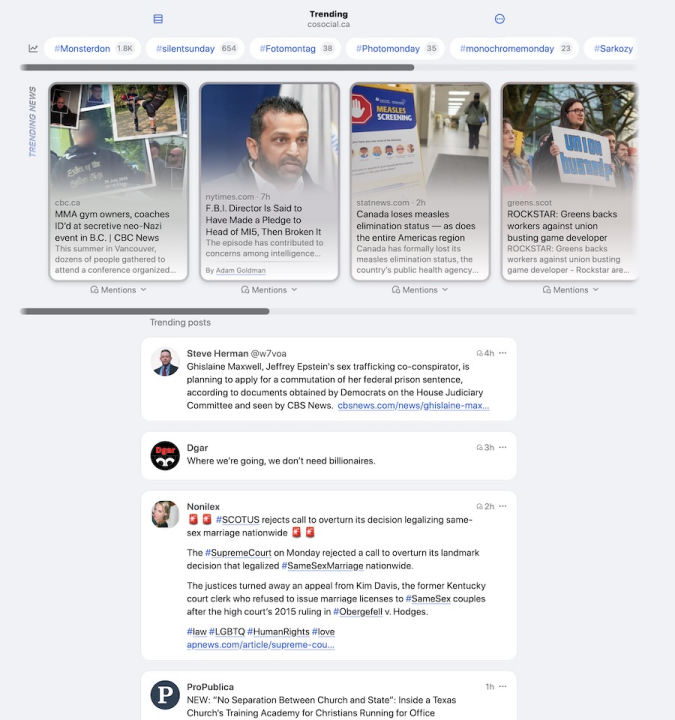
The “Trending” display in Phanpy.
I do think there’s room for improvement here; Bluesky has shown off the idea of pluggable feed-ranking algorithms, with many to choose from, and I like it. No reason in principle we couldn’t have the same thing on Mastodon.
Money
Every other social network has started with a big pot of money, whether from venture-capital investors (Twitter, Instagram) or from a Big Tech corporate parent (Google+, Threads). The people who provided that money want it back, plus a whole lot more. Thus, the manic drive for “engagement” and growth at all costs. They need to build huge data centers and employ an elite operations team plus an even more elite marketing group.
Mastodon, eh… a gaggle of nonprofits and co-ops and unincorporated affinity groups, financed by Patreon or low annual dues or Some Random Geek who enjoys running a server.
Since nobody owns it, nobody can extract a profit from it. Which means that from the big-money point of view, it’s entirely non-investable. The goal isn’t for anybody to make money, it’s to be instructive and intense and fun. It’s run on the cheap. You know what they call systems that are cheap and diversified? Resilient. Sustainable. Long-lived.
Last year I wrote: “Think of the Fediverse not as just one organism, but a population of mammals, scurrying around the ankles of the bigger and richer alternatives. And when those alternatives enshittify or fall to earth, the Fediversians will still be there.” After “scurrying” I should have added “and evolving”.
What about Bluesky?
I like the Bluesky people and their software, but I worry a lot about whether they’re really decentralized in practice, and even more about their financial future. I wrote up the details in Why Not Bluesky.
Mastodon’s the only option
The only social-media option, I mean, that’s decentralized, not owned or controlled by anyone, and working well today as you read this. It’s intense and interactive and fun. Why settle for less?
(Disclosure: I have no formal connections with the Mastodon organization, aside from being a low-level supporter on Patreon.)
Bye, Google Search 1 Nov 2025, 7:00 pm
For this blog, I mean. Which used to have a little search window in the corner of the banner just above that looked up blog fragments using Google. No longer; I wired in Pagefind; click on the magnifying glass up there on the right to try it out. Go ahead, do it now, I’ll wait before getting into the details.
The problem
Well, I mean, Google is definitely Part Of The Problem in advertising, surveillance, and Internet search. But the problem I’m talking about is that it just couldn’t find my pages, even when I knew they were here and knew words that should find them.
Either it dropped the entries from the index or dropped a bunch of search terms. Don’t know and don’t care now. ongoing is my outboard memory and I search it all the freaking time. This failure mode was making me crazy.
Pagefind
Tl;dr: I downloaded it and installed it and it Just Worked out of the box. I’d describe the look and feel but that’d be a waste of time since you just tried it out. It’s fast enough and doesn’t seem to miss anything and has a decent user interface.
How it works
They advertise “fully static search library”, which I assumed meant it’s designed to work against sites like this one composed of static files. And it is, but there’s more to it than that; read on.
First, you point a Node program at the root of your static-files tree and stand back. My tree has a bit over 5,000 files
containing about 2½ million words, adding up to a bit over 20M of text. By default, it assumes you’re indexing HTML and includes
all the text inside each page’s <body> element.
You have to provide a glob argument to match the files you want to index; in most cases, something like
root/**/*.html would do the trick. Working this out was for me the hardest part because among other things my
articles don’t end with .html; maybe it’ll be helpful for some to
note that what worked for ongoing
was:When/???x/????/??/??/[a-zA-Z0-9]<[\-_a-zA-Z0-9]:>
This produced an index organized into about 11K files adding up to about 78M. It includes a directory with one file per HTML page being searched.
I’d assumed I’d have to wire this up to my Web server somehow, but no: It’s all done in the client by fetching little bits and pieces of the index using ordinary HTTP GETs. For example, I ran a search for the word “minimal”, which resulted in my browser fetching a total of seven files totaling about 140K. That’s what they mean by “static”; not just the data, but the index too.
Finally, I noticed a couple of WASM files, so I had to check out the source code and, sure enough, this is basically a Rust app. Again I’m impressed. I hope that slick modern Rust/WASM code isn’t offended by me rubbing it up against this blog’s messy old Perl/Ruby/raw-JS/XML tangle.
Scalable?
Interesting question. For the purposes of this blog, Pagefind is ideal. But, indexing my 2½ million words burned a solid minute of CPU on the feeble VPS that hosts ongoing. I wonder if the elapsed time is linear in the data size, but it wouldn’t surprise me if it were worse. Furthermore, the index occupies more storage than the underlying data, which might be a problem for some.
Also, what happens when I do a search while the indexing is in progress? Just to be sure, I think I’ll wire it up to build the index in a new directory and switch indices as atomically as possible.
Finally, I think that if you wanted to sustain a lot of searches per second, you’d really want to get behind a CDN, which would make all that static index fetching really fly.
Configuring
The default look-and-feel was mostly OK by me, but the changes I had to make did involve quality time with the inspector, figuring out the class and ID complexities and then iterating the CSS.
The one thing that in the rear-view seems unnecessary is that I had to add a data-pagefind-meta attribute to the
element at the very bottom of the page where the date is to include it in the result list. There should be a way
to do this without custom markup. John Siracusa filed a
related bug.
Deployment
There’s hardly any work. I’ll re-run the indexer every day with a crontab entry and it looks it should just take care of itself.
To do?
Well, I could beautify the output some more but I’m pretty happy with it after just a little work. I can customize the sort order, which I gather is in descending order of how significant Pagefind thinks the match is. There’s a temptation to sort it in reverse date order. Actually, apparently I can also influence the significance algorithm. Anyhow I’ll run with mostly-defaults for now.
Search options
I notice that the software is pretty good at, and aggressive about, matching across verb forms and singular/plural and prefixes. Which I guess is what you want? You can apparently defeat that by enclosing a word in quotes if you want it matched exactly. Works for phrases too. I wonder what other goodies are in there; couldn’t find any docs on that subject.
Finally, there’s an excellent feature set I’ll never use; it’s smart about lots of languages. But alas, I write monolingually.
Shameful cleanup
Like I said, getting Pagefind installed and working was easy. Getting the CSS tuned up was a bit more effort. But I have to confess that I put hours and hours into hiding my dirty secrets.
You see, ongoing contains way more writing than you or Google can see. It’s set up so I can “semi-publish” pieces; there but unlinked. There was a whole lot of this kind of stuff: Photo albums from social events, pitches to employers about why they should hire various people including me, rants at employers for example about why Solaris should adopt the Linux userland (I was right) and why Android should include a Python SDK (I was right), and pieces that employer PR groups convinced me to bury. One of my minor regrets about no longer being employed is I no longer get to exercise my mad PR-group-wrangling skillz.
But when your search software is just walking the file tree, it doesn’t know what’s “published” and what’s not. I ended up
using my rusty shell muscles with xarg and sed and awk and even an ed(1)
script. I think I got it all, but who knows, search hard enough and you might find something embarrassing. If you do, I’d sure
appreciate an email.
Thanks!
To the folks who built this. Seems like a good thing.
Grokipedia 28 Oct 2025, 7:00 pm
Last night I had a very strange experience: About two thirds of the way through reading a Web page about myself, Tim Bray, I succumbed to boredom and killed the tab. Thus my introduction to Grokipedia. Here are early impressions.
On Bray
My Grokipedia entry has over seven thousand words, compared to a mere 1,300 in my Wikipedia article. It’s pretty clear how it was generated; an LLM, trained on who-knows-what but definitely including that Wikipedia article and this blog, was told to go nuts.
Speaking as a leading but highly biased expert on the subject of T. Bray, here are the key take-aways:
(Overly) complete
It covers all the territory; there is no phase of my life’s activity that could possibly be encountered in combing the Web that is not exhaustively covered. In theory this should be good but in fact, who cares about the details of what I worked on at Sun Microsystems between 2004 and 2010? I suppose I should but, like I said, I couldn’t force myself to plod all the way through it.
Wrong
Every paragraph contains significant errors. Sometimes the text is explicitly self-contradictory on the face of it, sometimes the mistakes are subtle enough that only I would spot them.
Style
The writing has that LLM view-from-nowhere flat-affect semi-academic flavor. I don’t like it but the evidence suggests that some people do?
References
All the references are just URLs and at least some of them entirely fail to support the text. Here’s an example. In discussion of my expert-witness work for the FTC in their litigation against Meta concerning its acquisitions of Instagram and WhatsApp, Grokipedia says:
[Bray] opined that users' perceptions of response times in online services critically influence market dynamics.
It cites Federal Trade Commission’s Reply to Meta Platforms, Inc.’s Response to Federal Trade Commission’s Counterstatement of Material Facts (warning: 2,857-page PDF). Okay, that was one of the things I argued, but the 425 pages of court documents that I filed, and the references to my reporting in the monster document, make it clear that it was one tiny subset of the main argument.
Anyhow, I (so that you won’t have to) spent a solid fifteen minutes spelunking back and forth through that FTC doc, looking for strings like “response time” and “latency” and so on. Maybe somewhere in those pages there’s support for the claim quoted above, but I couldn’t find it.
Useful?
Wikipedia, in my mind, has two main purposes: A quick visit to find out the basics about some city or person or plant or whatever, or a deep-dive to find out what we really know about genetic linkages to autism or Bach’s relationship with Frederick the Great or whatever.
At the moment, Grokipedia doesn’t really serve either purpose very well. But, after all, this is release 0.1, maybe we should give it a chance.
Or, maybe not.
Woke/Anti-Woke
The whole point, one gathers, is to provide an antidote to Wikipedia’s alleged woke bias. So I dug into that. Let’s consider three examples of what I found. First, from that same paragraph about the FTC opinion quoted above:
While Bray and aligned progressives contend that such dominance stifles innovation by enabling predatory acquisitions and reduced rivalry—evidenced by fewer startup exits in concentrated sectors—counterarguments highlight that Big Tech's scale has fueled empirical gains, with these firms investing over $240 billion in U.S. R&D in 2024 (more than a quarter of national totals) and driving AI, cloud, and patent surges.[128] [131] Six tech industries alone accounted for over one-third of U.S. GDP growth from 2012–2021, comprising about 9% of the economy and sustaining 9.3 million jobs amid falling consumer prices and rapid technological diffusion. [132] [133] Right-leaning economists often defend consumer welfare metrics and market self-correction, warning that forced divestitures risk eroding the efficiencies and investment incentives that have propelled sector productivity above 6% annual growth in key areas like durable manufacturing tech. [134] [135]
I’ve linked the numbered citations to the indicated URLs. Maybe visit one or two of them and see what you think? Four are to articles arguing, basically, that monopolies must be OK because the companies accused of it are growing really fast and driving the economy. They seem mostly to be from right-wing think-tanks but I guess that’s what those think-tanks are for. One of them, #131, Big Tech and the US Digital-Military-Industrial Complex, I think isn’t helpful to the argument at all. But still, it’s broadly doing what they advertise: Pushing back against “woke” positions, in this case the position that monopolization is bad.
I looked at a couple of other examples. For example, this is from the header of the Greta Thunberg article:
While credited with elevating youth engagement on environmental issues, Thunberg's promotion of urgent, existential climate threats has drawn scrutiny for diverging from nuanced empirical assessments of climate risks and adaptation capacities, as well as for extending her activism into broader political arenas such as anti-capitalist and geopolitical protests.[5][6]
Somehow I feel no urge to click on those citation links.
If Ms Thunberg is out there on the “woke” end of the spectrum, let’s flit over to the other end, namely the entry for J.D. Vance, on the subject of his book Hillbilly Elegy.
Critics from progressive outlets, including Sarah Smarsh in her 2018 book Heartland, faulted the memoir for overemphasizing personal and cultural failings at the expense of structural economic policies, arguing it perpetuated stereotypes of rural whites as self-sabotaging.[71] These objections, often rooted in institutional analyses from academia and media, overlooked data on behavioral patterns like opioid dependency rates—peaking at 21.5 deaths per 100,000 in Appalachia around 2016—that aligned with Vance's observations of "deaths of despair" precursors.[72]
I read and enjoyed Heartland but the citation is to a New Yorker article that doesn’t mention Smarsh. As for the second sentence… my first reaction as I trudged through its many clauses, was “life’s too short”. But seriously, opioid-death statistics weaken the hypothesis about structural economic issues? Don’t get it.
Take-away
Wikipedia is, to quote myself, the encyclopedia that “anyone who’s willing to provide citations can edit”. Grokipedia is “the encyclopedia that Elon Musk’s LLM can edit, with sketchy citations and no progressive argument left un-attacked.”
So I guess it’s Working As Intended?
Recent Music 15 Oct 2025, 7:00 pm
There are musical seasons where I re-listen to the old faves, the kind of stuff you can read about in my half-year of “Song of the Day” essays from 2018. This autumn I find myself listening to new music by living people. Here’s some of it.
The musical influx is directly related to my adoption of Qobuz, whose weekly editors’-picks are always worth a look and have led me to more than half of the tunes in this post. Qobuz, like me, still believes in the album as a useful unit of music and thus I’ll cover a few of those. And live-performance YouTubes of course. You’ll spot a pattern: A lot of this stuff is African or African-adjacent with Euro angles and jazz flavors.
Ghana Downtown
The Kwashibu Area Band, founded in Accra, have been around for a few years and played in a few styles, sometimes as Pat Thomas’ band.

What happened was, Qobuz offered up their recent Love Warrior’s Anthem and there isn’t a weak spot on it. Their record label says something about mixing Highlife and jazz; OK I guess. Here’s their YouTube channel but it doesn’t seem to have anything live from the Love-Warrior material. It isn’t often that I listen to an entire album end-to-end more than once.

Posted to Flickr by p_a_h, licensed under the Creative Commons Attribution 4.0 International license.
Loud Rude Brits
The New Eves are from Brighton and Wikipedia calls them “folk punk” which is weird because yeah, they’re loud and rude, but a lot of the instrumental sound is cello/violin/flute. Anyhow, check out Mother. I listened to most of their recent LP The New Eve Is Rising while driving around town and that’s really a lot of good and very intense music.
Rwanda Sings With Strings
That’s the title of the latest from “The Good Ones”, here it is on BandCamp. Adrien Kazigira and Janvier Havugimana are described as a “folk duo”; the songs are two-voice harmonies backed with swinging acoustic guitars. This record is just like the title says: They set up in a hotel room with a couple of string players and recorded these songs in a single take with no written music and no overdubs.

It’s awfully sweet stuff and while none of the lyrics are in English, they offer translations of the song titles, which include One Red Sunday, You Lied & Tried to Steal My Land, In the Hills of Nyarusange They Talk Too Much, and You Were Given a Dowry, But Abandoned Me. This music does so much with so little.
Rapper Piano
Alfa Mist was a rapper who went to music school and learned to play keyboards as an adult. The music’s straight-ahead Jazz but he still raps a bit here and there, it blends in nicely. If you get a chance to listen to an interview with him you should, if only for his voice; he’s from South London and of Ugandan heritage, which results in an accent like nothing I’ve ever heard before but makes me smile.

By Dirk Neven - Alfa Mist, Maassilo Rotterdam 20 November 2022 - Alfa Mist, CC0, (Wikimedia).
The problem with AM’s music is that’s it’s extremely smoooooooth, to the point that I thought of it as sort of pleasant-background stuff. Then I took in a YouTube of a live-in-studio session (maybe this one?) and realized that I was listening to extremely sophisticated soloing and ensemble playing that deserves to be foreground. But still sweet.

By World Trade Organization from Switzerland, cropped by User:HLHJ - Aid for Trade Global Review 2017 – Day 1, CC BY-SA 2.0, (Wikimedia).
Kora Magic
The Kora is that Gambian instrument with a gourd at the botton and dozens of strings. Sona Jobarteh, British-Gambian, plays Kora and guitar and sings beautifully and has a great band. Here she is at Jazz à Parquerolles.

And now for something completely different
Vanessa Wagner is a French classical pianist of whom I’d not heard. But Qobuz offered a new recording of Phil Glass’s Piano Etudes which, despite being a big fan, I’d never listened to. Here’s Etude No. 2, which is pretty nice, as is the whole recording; dreamy, shimmering stuff. I found myself leaning back with eyes closed.
It makes me happy
That there’s plenty of music out there that’s new and good.
Social Media Provenance Challenge 1 Oct 2025, 7:00 pm
At a a recent online conference, I said that we can “change the global Internet conversation for the better, by making it harder for liars to lie and easier for truth-tellers to be believed.” I was talking about media — images, video, audio. We can make it much easier to tell when media is faked and when it’s real. There’s work to do, but it’s straightforward stuff and we could get there soon. Here’s how.
The Nadia story
This is a vision of what success looks like.
Nadia lives in LA. She has a popular social-media account with a reputation for stylish pictures of urban life. She’s not terribly political, just a talented street photog. Her handle is “CoolTonesLA@hotpix.example”.
She’s in Venice Beach the afternoon of Sunday August 9, 2026, when federal agents take down a vendor selling cheap Asian ladies’ wear. She gets a great shot of an enforcer carrying away an armful of pretty dresses while two more bend the merchant over his countertop. None of the agents in the picture are in uniform, all are masked.
She signs into her “CoolTonesLA” account on hotpix.example and drafts a post saying “Feds raid Venice
Beach”. When she uploads
the picture, there’s a pop-up asking “Sign this
image?” Nadia knows what this means, and selects “Yes”. By midnight her post has gone viral.

As a result of Nadia agreeing to “sign” the image, anyone who sees her post, whether in a browser or mobile app, also sees that little “Cr” badge in the photo’s top right corner. When they mouse over it, a little pop-up says something like:
Signature is valid.
Media was posted by @CoolTonesLA
on hotpix.example
at 5:40 PM PDT, August 9th, 2026.
The links point to Nadia’s feed and her instance’s home page. Following them can give the reader a feeling for what kind of person she is, the nature of her server, and the quality of her work. Most people are inclined to believe the photo is real.
Marco is a troublemaker. He grabs Nadia’s photo and posts it to his social-media account with the caption “Criminal illegals terrorize local business. Lock ’em up!” He’s not technical and doesn’t strip the metadata. Since the picture is already signed, he doesn’t get the “Sign this picture?” prompt. Anyone who sees his post will see the “Cr” badge and mousing over it makes it pretty clear that it isn’t what he says it is. Commenters gleefully point this out. By the time Marco takes the post down, his credibility is damaged.
Maggie is a more technical troublemaker. She sees Marco’s post and likes it, strips the picture’s metadata, and reposts it. When she gets the “Sign this picture?” prompt, she says “No”, so it doesn’t get a “Cr” badge. Hostile commenters accuse her of posting a fake, saying “LOL badge-free zone”. It is less likely that her post will go viral.
Miko isn’t political but thinks the photo would be more dramatic if she Photoshopped it to add a harsh dystopian lighting effect. When she reposts her version, the “Cr” badge won’t be there because the pixels have changed.
Morris follows Maggie. He grabs the stripped picture and, when he posts it, says “Yes” to signing. In his post the image will show up with the “Cr” and credit it to him, with a “posted” timestamp later than Nadia’s initial post. Now, the picture’s believability will depend on Morris’s. Does he have a credible track record? Also, there’s a chance that someone will notice what Morris did and point out that he stole Nadia’s picture.
(In fact, I wouldn’t be surprised if people ran programs against the social-network firehose looking for media signed by more than one account, which would be easy to detect.)
That’s the Nadia story.
How it’s done
The rest of this piece explains in some detail how the Nadia story can be supported by technology that already exists, with a few adjustments. If jargon like “PKIX” and “TLS” and “Nginx” is foreign to you, you’re unlikely to enjoy the following. Before you go, please consider: Do you think making the Nadia story come true would be a good investment?
I’m not a really deep expert on all the bits and pieces, so it’s possible that I’ve got something wrong. Therefore, this blog piece will be a living document in that I’ll correct any convincingly-reported errors, with the goal that it accurately describes a realistic technical roadmap to the Nadia story.
By this time I’ve posted enough times about C2PA that I’m going to assume people know what it is and how it works. For my long, thorough explainer, see On C2PA. Or, check out the Content Credentials Web site.
Tl;dr: C2PA is a list of assertions about a media object, stored in its metadata, with a digital signature that includes the assertions and the bits of the picture or video.
This discussion assumes the use of C2PA and also an in-progress specification from the Creator Assertions Working Group (CAWG) called Identity Assertion.
Not all the pieces are quite ready to support the Nadia story. But there’s a clear path forward to closing each gap.
“Sign this picture?”
C2PA and CAWG specify many assertions that you can make about a piece of media. For now let’s focus just on what we need for provenance. When the media is uploaded to a social-network service, there are two facts that the server knows, absolutely and unambiguously: Who uploaded it (because they’ve had to sign in) and when it happened.
In the current state of
the specification drafts, “Who” is the cawg.social_media property from the draft
Identity Assertion spec, section
8.1.2.5.1, and “When” is the c2pa.time-stamp property from the
C2PA
specification, section 18.17.3.
I think these two are all you need for a big improvement in social network media provenance, so let’s stick with them.
What key?
Let’s go back to the Nadia story.
It needs the Who/When assertions to be digitally signed in a way that will convince a tech-savvy human or a PKIX validation
library that the signature could only have been applied by the server at hotpix.example.
The C2PA people have been thinking about this. They are working on a Verified News Publishers List, to be maintained and managed by, uh, that’s not clear to me. The idea is that C2PA software would, when validating a digital signature, require that the PKIX cert is one of those on the Publishers List.
This isn’t going to work for a decentralized social network, which has tens of thousands of independent servers run by co-ops, academic departments, municipal governments, or just a gaggle of friends who kick in on Patreon. And anyhow, Fediverse instances don’t claim to be “News Publishers”, verified or not.
So what key can hotpix.example sign with?
Fortunately, there’s already a keypair and PKIX certificate in place on every social-media server, the one it uses to
support TLS connections. The one at tbray.org, that’s being used right now to protect your interaction
with this blog, is in /etc/letsencrypt/live/ and the private key is obviously not generally readable.
That cert will contain the public key corresponding to the host’s private key, the cert's ancestry, and the host name.
It’s all that any PKIX library needs to verify that yes, this could only have been signed by
hotpix.example. However, there will be objections.
Objection: “hotpix.example is not a Verified News Publisher!” True enough, the C2PA validation libraries would
have to accept X.509 certs. Maybe they do already? Maybe this requires an extension of the current specs? In any
case, the software’s all open-source, could be forked if necessary.
Objection: “That cert was issued for the purpose of encrypting TLS connections, not for some weird photo provenance application. Look at the OID!” OK, but seriously, who cares? The math does what the math does, and it works.
Objection: “I have to be super-careful about protecting my private key and I don’t want to give a copy to the hippies running the social-media server.” I sympathize but, in most cases, social media is all that server’s doing.
Having said that, it would be great if there were extensions to Nginx and Apache httpd where you could request that they sign the assertions for you. Neither would be rocket science.
OK, so we sign Nadia’s Who/When assertions and her photo’s pixels with our host’s TLS key, and ship it off into the world. What’s next?
How to validate?
Verifying these assertions, in a Web or mobile app, is going to require a C2PA library to pick apart the assertions and a PKIX library for the signature check.
We already have c2pa-rs, Rust code with MIT and Apache licenses. Rust libraries can be called from some other programming languages but in the normal course of affairs I’d expect there soon to be native implementations. Once again, all these technologies are old as dirt, absolutely no rocket science required.
How about validating the signatures? I was initially puzzled about this one because, as a
programmer, certs only come into the picture when I do something like http.Get() and the
library takes care of all that stuff. So I can’t speak from experience.
But I think the infrastructure is there. Here’s a Curl blogger praising Apple SecTrust. Over on Android, there’s X509ExtendedTrustManager. I assume Windows has something. And if all else fails, you could just download a trusted-roots file from the Curl or Android projects and refresh it every week or two.
What am I missing?
This feels a little too easy, something that could be done in months not years. Perhaps I’m oversimplifying. Having said that, I think the most important thing to get right is the scenarios, so we know what effect we want to achieve.
What do you think of the Nadia story?
GenAI Predictions 26 Sep 2025, 7:00 pm
I’m going to take a big chance here and make predictions about GenAI’s future. Yeah, I know, you’re feeling overloaded on this stuff and me too, but it seems to have sucked the air out of all the other conversations. I would so like to return to arguing about Functional Programming or Free Trade. This is risky and there’s a pretty good chance that I’m completely wrong. But I’ll try to entertain while prognosticating.
Reverse Centaurs
That’s the title of a Cory Doctorow essay, which I think is spot on. I’m pretty sure anyone who’s read even this far would enjoy it and it’s not long, and it’d help understand this. Go have a look, I’ll wait.
Hallucinations won’t get fixed
I have one good and one excellent argument to support this prediction. Good first: While my understanding of LLMs is not that deep, it doesn’t have to be to understand that it’s really difficult (as in, we don’t know how) to connect the model’s machinations to our underlying reality, so as to fact-check.
The above is my non-expert intuition at work. But then there’s Why Language Models Hallucinate, three authors from OpenAI and one from Georgia Tech, which seems to show that hallucinations are an inevitable result of current training practices.
And here’s the excellent argument: If there were a way to eliminate the hallucinations, somebody already would have. An army of smart, experienced people, backed by effectively infinite funds, have been hunting this white whale for years now without much success. My conclusion is, don’t hold your breath waiting.
Maybe there’ll be a surprise breakthrough next Tuesday. Could happen, but I’d be really surprised.
(When it comes to LLMs and code, the picture is different; see below.)
The mass layoffs won’t happen
The central goal of GenAI is the elimination of tens of millions of knowledge workers. That’s the only path to the profits that can cover the costs of training and running those models.
To support this scenario the AI has to run in Cory’s “reverse centaur” mode, where the models do the work and the humans tend them. This allows the production of several times more work per human, generally of lower quality, with inevitable hallucinations. There are two problems here: First, that at least some of the output is workslop, whose cleanup costs eat away at the productivity wins. Second, that the lower quality hurts your customers and your business goes downhill.
I just don’t see it. Yeah, I know, every CEO is being told that this will work and they’ll be heroes to their shareholders. But the data we have so far keeps refusing to support those productivity claims.
OK then, remove the “reverse” and run in centaur mode, where smart humans use AI tools judiciously to improve productivity and quality. Which might be a good idea for some people in some jobs. But in that scenario neither the output boost nor the quality gain get you to where you can dismiss enough millions of knowledge workers to afford the AI bills.
The financial damage will be huge
Back to Cory, with The real (economic) AI apocalypse is nigh. It’s good, well worth reading, but at this point pretty well conventional wisdom as seen by everyone who isn’t either peddling a GenAI product or (especially) fundraising to build one.
To pile on a bit, I’m seeing things every week like for example this: The AI boom is unsustainable unless tech spending goes ‘parabolic,’ Deutsche Bank warns: ‘This is highly unlikely’.
The aggregate investment is ludicrous. The only people who are actually making money are the ones selling the gold-mining equipment to the peddlers. Like they say, “If something cannot go on forever, it will stop.” Where by “forever”, in the case of GenAI, I mean “sometime in 2026, probably”.
… But the economy won’t collapse
Cory forecasts existential disaster, but I’m less worried. Those most hurt when the bubble collapses will be the investing classes who, generally speaking, can afford it. Yeah, if the S&P 500 drops by a third, the screaming will shake the heavens, but I honestly don’t see it hitting as hard as 2008 and don’t see how the big-picture economy falls apart. That work that the genAI shills say would be automated away is still gonna have to be done, right?
The software profession will change, but not that much
Here’s where I get in trouble, because a big chunk of my professional peers, including people I admire, see GenAI-boosted coding as pure poison: “In a kind of nihilistic symmetry, their dream of the perfect slave machine drains the life of those who use it as well as those who turn the gears.” (The title of that essay is “I Am An AI Hater.”)
I’m not a hater. I argued above that LLMs generating human discourse have no way to check their output for consistency with reality. But if it’s code, “reality” is approximated by what will compile and build and pass the tests. The agent-based systems iteratively generate code, reality-check it, and don’t show it to you until it passes. One consequence is that the quality of help you get from the model should depend on the quality of your test framework. Which warms my testing-fanatic heart.
So, my first specific prediction: Generated code will be a routine thing in the toolkit, going forward from here. It’s pretty obvious that LLMs are better at predicting code sequences than human language.
In Revenge of the junior developer, Steve Yegge says, more or less, “Resistance is useless. You will be assimilated.” But he’s wrong; there are going to be places where we put the models to work, and others where we won’t. We don’t know which places those are and aren’t, but I have (weaker) predictions; let’s be honest and just say “guesses”.
Where I suspect generated code will likely appear:
Application logic: “Depreciate the values in the
AMOUNTfield of theINSTALLEDtable forward ten years and write theNAMEfield and the depreciated value into a CSV.” Or “Look at JIRA ticket 248975 and create a fix.”(By the way, this is a high proportion of what actual real-world programmers do every day.)
Glorified StackOverflow-style lookups like I did in My First GenAI Code.
Drafting code that needs to run against interfaces too big and complex to hold in your head, like for example the Android and AWS APIs (“When I shake the phone, grab the location from GPS and drop it in the
INCOMINGS3 bucket”). Or CSS (“Render that against a faded indigo background flush right, and hold it steady while scrolling so the text slides around it”).SQL. This feels like a no-brainer. So much klunky syntax and so many moving pieces.
Where I suspect LLM output won’t help much.
Interaction design. I mean, c’mon, it requires predicting how humans understand and behave.
Low level infrastructure code, the kind I’ve spent my whole life on, where you care a whole lot about about conserving memory and finding sublinear algorithms and shrinking code paths and having good benchmarks.
Here are areas where I don’t have a prediction but would like to know whether and how LLM fits in (or not).
Help with testing: Writing unit and integration tests, keeping an eye on coverage, creating a bunch of BDD tests from a verbal description of what a function is going to do.
Infrastructure as code: CI/CD, Terraform and peers, all that stuff. There are so many ways to get it wrong.
Bad old-school concurrency that uses explicit mutexes and
java.lang.Threadwhere you have to understand language memory models and suchlike.
The real reason not to use GenAI
Because it’s being sold by a panoply of grifters and chancers and financial engineers who know that the world where their dreams come true would be generally shitty, and they don’t care.
(Not to mention the environmental costs and the poor folk in the poor countries where the QA and safety work is outsourced.)
Final prediction: After the air goes out of the assholes’ bubble, we won’t have to live in the world they imagine. Thank goodness.
C2PA Investigations 18 Sep 2025, 7:00 pm
This is the blog version of my talk at the IPTC’s online Photo Metadata Conference conference. Its title is the one the conference organizers slapped on my session without asking; I was initially going to object but then I thought of the big guitar riff in Dire Straits’ Private Investigations and snickered. If you want, instead of reading, to watch me present, that’s on YouTube. Here we go.
Hi all, thanks for having me. Today I represent… nobody, officially. I’m not on any of the committees nor am I an employee of any of the providers. But I’m a photographer and software developer and social-media activist and have written a lot about C2PA. So under all those hats this is a subject I care about.
Also, I posted this on Twitter back in 2017.
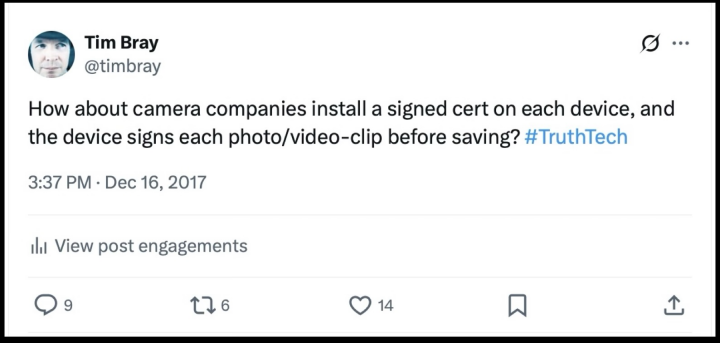
I’m not claiming that I was the first with this idea, but I’ve been thinking about the issues for quite a while.
Enough self-introduction. Today I’m going to look at C2PA in practice right now in 2025. Then I’m going to talk about what I think it’s for. Let’s start with a picture.

This smaller version doesn’t have C2PA,
but if you click on it, the larger version you get does.
Photo credit: Rob Pike
I should start by saying that a few of the things that I’m going to show you are, umm, broken. But I’m still a C2PA fan. Bear in mind that at this point everything is beta or preview or whatever, at best v1.0. I think we’re in glass-half-full mode.
This photo is entirely created and processed by off-the-shelf commercial products and has content credentials, and let me say that I had a freaking hard time finding such a photo. There are very few Content Credentials out there on the Internet. That’s because nearly every online photo is delivered either via social media or by professional publishing software. In both cases, the metadata is routinely stripped, bye-bye C2PA. So one of the big jobs facing us in putting Content Credentials to work is to stop publishers from deleting them.
Of course, that’s complicated. Professional publishers probably want the Content Credentials in place, but on social media privacy is a key issue and stripping the metadata is arguably a good default choice. So there are a lot of policy discussions to be had up front of the software work.
Anyhow, let’s look at the C2PA.

I open up that picture in Chrome and there are little “Cr” glyphs at both the top left and top right corners; that’s because I’ve installed multiple C2PA Chrome plug-ins. Turns out these seem to only be available for Chrome, which is irritating. Anyhow, I’ve clicked on the one in the top left.
That’s a little disappointing. It says the credentials were recorded by Lightroom, and gives my name, but I think it’s hiding way more than it’s revealing. Maybe the one on the top right will be more informative?

More or less the same info. A slightly richer presentation But both displays have an “inspect” button and both do the same thing. Let’s click it!

This is the Adobe Content Credentials inspector and it’s broken. That’s disappointing. Having said that, I was in a Discord chat with a senior Adobe person this morning and they’re aware of the problem.
But anyhow, I can drag and drop the picture like they say.

Much much better. It turns out that this picture was originally taken with a Leica M11-P. The photographer is a famous software guy named Rob Pike, who follows me on Mastodon and wanted to help out.
So, thanks Rob, and thanks also to the Leica store in Sydney, Australia, who loaned him the M11. He hasn’t told me how he arranged that, but I’m curious.
I edited it in Lightroom, and if you look close, you can see that I cropped it down and brightened it up. Let’s zoom in on the content credentials for the Leica image.
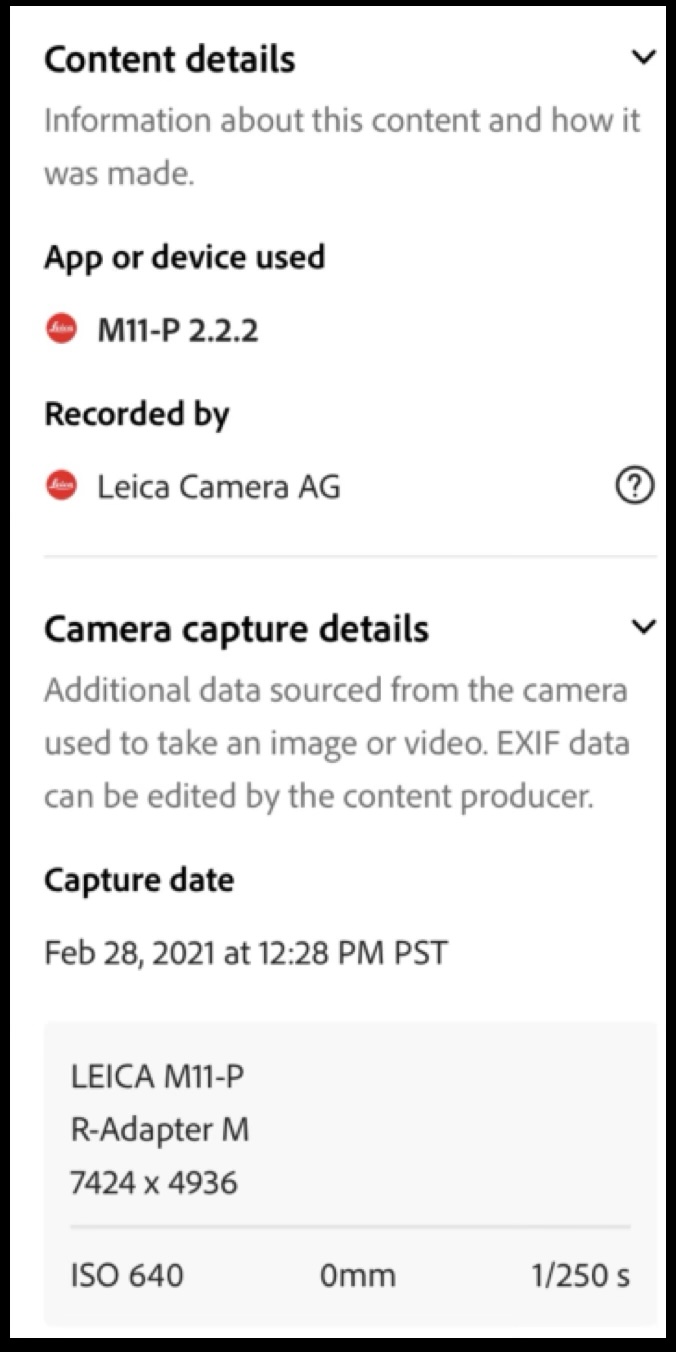
There’s the camera model, the capture date (which is wrong because Rob didn’t get around to setting the camera’s date before he took the picture.) The additional hardware (R-Adapter-M), the dimensions, ISO, focal length, and shutter speed.
Speaking as a photographer, this is kind of cool. There’s a problem in that it’s partly wrong. The focal length isn’t zero, and Rob is pretty sure he didn’t have an adapter on. But Leica is trying to do the right thing and they’ll get there.
Now let’s look at the assertions that were added by Lightroom.

There’s a lot of interesting stuff in here, particularly the provenance. Lightroom lets you manage your identities, using what we call “OAuth flows”, so it can ask Instagram (with my permission) what my Instagram ID is. It goes even further with LinkedIn; it turns out that LinkedIn has an integration with the Clear ID people, the ones who fast-track you at the airport. So I set up a Clear ID, which required photos of my passport, and went through the dance with LinkedIn to link it up, and then with Lightroom so it knew my LinkedIn ID. So to expand, what it’s really saying is: “Adobe says that LinkedIn says that Clear says that the government ID of the person who posted this says that he’s named Timothy Bray”.
I don’t know about you, but this feels like pretty strong provenance medicine to me. I understand that the C2PA committee and the CAWG people are re-working the provenance assertions. To them: Please don’t screw this particular style of provenance up.
Now let’s look at what Lightroom says it did. It may be helpful to know what I in fact did.
Cropped the picture down.
Used Lightroom’s “Dehaze” tool because it looked a little cloudy.
Adjusted the exposure and contrast, and boosted the blacks a bit.
Sharpened it up.
Lightroom knows what I did, and you might wonder how it got from those facts to that relatively content-free description that reads like it was written by lawyers. Anyhow, I’d like to know. Since I’m a computer geek, I used the open-source “c2patool” to dump what the assertions actually are. I apologize if this hurts your eyes.
It turns out that there is way more data in those files than the inspector shows. For example, the Leica claims included 29 EXIF values, here are three I selected more or less at random:
"exif:ApertureValue": "2.79917", "exif:BitsPerSample": "16", "exif:BodySerialNumber": "6006238",
Some of these are interesting: In the Leica claims, the serial number. I could see that as a useful provenance claim. Or as a potentially lethal privacy risk. Hmmm.
{ "action": "c2pa.color_adjustments", "parameters": { "action": "c2pa.color_adjustments", "parameters": { "com.adobe.acr.value": "60", "com.adobe.acr": "Exposure2012" } }, { "action": "c2pa.color_adjustments", "parameters": { "com.adobe.acr": "Sharpness", "com.adobe.acr.value": "52" } }, { "action": "c2pa.cropped", "parameters": { "com.adobe.acr.value": "Rotated Crop", "com.adobe.acr": "Crop" } }
And in the Lightroom section, it actually shows exactly what I did, see the sharpness and exposure values.
My feeling is that the inspector is doing either too much or too little. At the minimal end you could just say “hand processed? Yes/No” and “genAI? Yes/No”. For a photo professional, they might like to drill down and see what I actually did. I don’t see who would find the existing presentation useful. There’s clearly work to do in this space.
Oh wait, did I just say “AI”? Yes, yes I did. Let’s look at another picture, in this case a lousy picture.

I was out for a walk and thought the building behind the tree was interesting. I was disappointed when I pulled it up on the screen, but I still liked the shape and decided to try and save it.

So I used Lightroom’s “Select Sky” to recover its color, and “Select Subject” to pull the building details out of the shadows. Both of these Lightroom features, which are pretty magic and I use all the time, are billed as being AI-based. I believe it.
Let’s look at what the C2PA discloses.
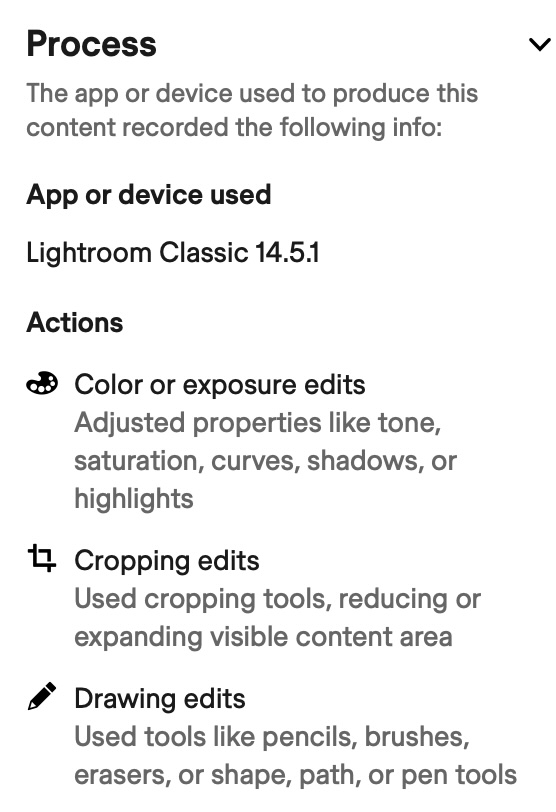
Having said all that, if you look at the C2PA (or at the data behind it) Lightroom discloses only “Color or Exposure”, “Cropping”, and “Drawing” edits. Nothing about AI.
Hmm. Is that OK? I personally think it is, and highlights the distinction between what I’d call “automation” AI and Generative AI. I mean, selecting the sky and subject is something that a skilled Photoshop user could accomplish with a lot of tinkering, the software is just speeding things up. But I don’t know, others might disagree.
Well, how about that generative AI?

Fails c2patool validation, “DigitalSourceType” is trainedAlgorithmicMedia

“DigitalSourceType” is compositeWithTrainedAlgorithmicMedia
The turtle is 100% synthetic, from ChatGPT, and on the right is a Pixel 10 shot on which I did a few edits including “Magic Eraser”. Both of these came with Content Credentials; chatGPT’s is actually invalid, but on the glass-half-full front, the Pixel 10’s were also invalid up until a few days ago, then they fixed it. So this stuff does get fixed.
I’m happy about the consistent use of C2PA terminology, they are clearly marking the images as genAI-involved.
I’m about done talking about the state of the Content Credentials art generally but I should probably talk about this device.
Because it marks the arrival of Content Credentials on the mass consumer market. Nobody knows how many Pixels Google actually sells but I guarantee it’s a lot more than Leica sells M11’s. And since Samsung tends to follow Google pretty closely, we’re heading for tens then hundreds of millions of C2PA-generating mobile devices. I wonder when Apple will climb on board?
Let’s have a look at that C2PA.
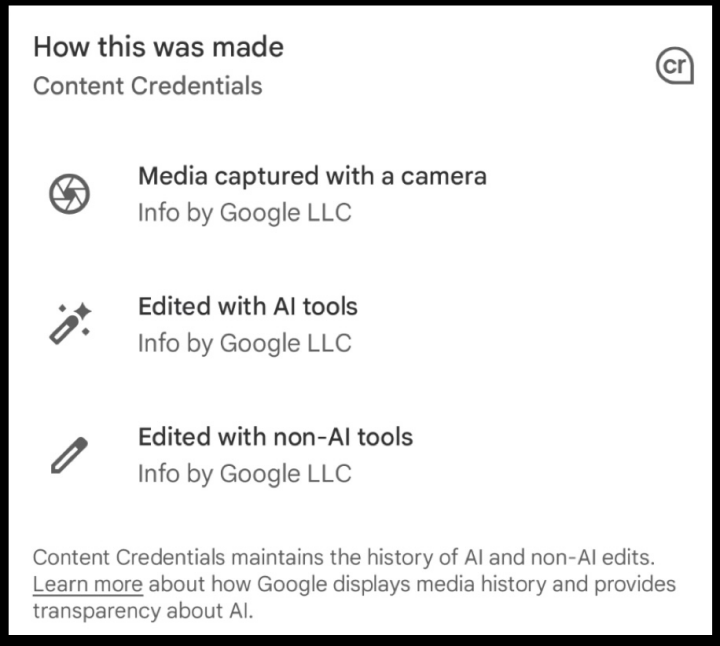
This view of the C2PA is from the Google Photos app. It’s very limited. In particular, there is nothing in there to support provenance. In fact, it’s the opposite, Google is bending over backward to avoid anything that could be interpreted as breaking the privacy contract by sharing information about the user.
Let’s pull back the covers and dig a little deeper. Here are a few notes
The device is identified just as “Pixel camera”. There are lots of different kinds of those!
The C2PA inclusion is Not optional!
DigitalSourceType:
computationalCapture(if no genAI)Timestamp is “untrusted”
The C2PA not being optional removes a lot of UI issues but still, well, I’m not smart enough to have fully thought through the implications. That Digital Source Type looks good and appropriate, and the untrusted-ness of the timestamp is interesting.
You notice that my full-workflow examples featured a Leica rather than the Pixel, and that’s because the toolchain is currently broken for me: Neither Lightroom nor Photoshop can handle the P10 C2PA. I’ll skip the details, except to say that Adobe is aware of the bug, a version mismatch, and they say they’re working on it.
Before we leave the Pixel 10, I should say that there are plenty of alternate camera apps in Android and iOS, some quite good, and it’d be perfectly possible for them to ship much richer C2PA, notably including provenance, location, and so on.
I guess that concludes my look at the current state of the Content Credentials art. Now I’d like to talk about what Content Credentials are for. To start with, I think it’d be helpful to sort the assertions into three baskets.

Capture, that’s like that Leica EXIF stuff we showed earlier. What kind of camera and lens, what the shooting parameters were. Processing, that’s like the Lightroom report: How was the image manipulated, and by what software. Provenance: Which person or organization produced this?
But I think this picture has an important oversimplification, let me fix that.

Processing is logically where you’d disclose the presence of GenAI. And in terms of what people practically care about, that’s super important and deserves special consideration.
Now I’m going to leave the realm of facts and give you opinions. As for the Capture data there on the left… who cares? Really, I’m trying to imagine a scenario in which anyone cares about the camera or lens or F stop. I guess there’s an exception if you want to prove that the photo was taken by one of Annie Liebowitz’s cameras, but that’s really provenance.
Let’s think about a professional publication scenario. They get photos from photographers, employees or agencies or whatever. They might want to be really sure that the photo was from the photographer and not an imposter. So having C2PA provenance would be nice. Then when the publisher gets photos, they do a routine check of the provenance and if it doesn’t check out, they don’t run the picture without a close look first.
They also probably want to check for the “is there genAI?” indicator in the C2PA, and, well, I don’t know what they might do, but I’m pretty sure they’d want to know.
That same publisher might want to equip the photos they publish with C2PA, to demonstrate that they are really the ones who chose and provided the media. That assertion should be applied routinely by their content management system. Which should be easy, on the technology side anyhow.
So from the point of view of a professional publisher, provenance matters, and being careful about GenAI matters, and in the C2PA domain, I think that’s all that really matters.
Now let’s turn to Social Media, which is the source of most of the images that most people see most days. Today, all the networks strip all the photo metadata, and that decision involves a lot of complicated privacy and intellectual-property thinking. But there is one important FACT that they know: For any new piece of media, they know which account uploaded the damn thing, because that account owner had to log in to do it. So I think it’s a no-brainer that IF THE USER WISHES, they can have a Content Credentials assertion in the photo saying “Initially uploaded by Tim Bray at LinkedIn” or whoever at wherever.
What we’d like to achieve is that if you see some shocking or controversial media, you’d really want to know who originally posted it before you decided whether you believed it, and if Content Credentials are absent, that’s a big red flag. And if the picture is of the current situation in Gaza, your reaction might be different depending on whether it was originally from an Israeli military social-media account, or the Popular Front for the Liberation of Palestine, or by the BBC, or by igor282356057@popular.online.
Anyhow, here’s how I see it:
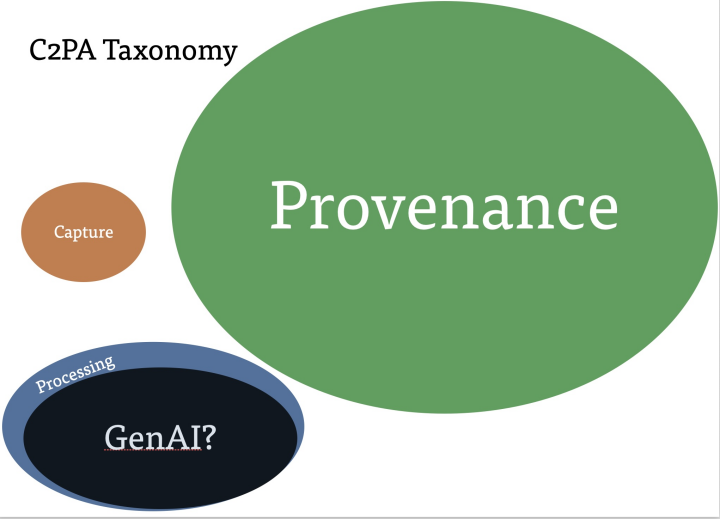
So for me, it’s the P and A in C2PA that matter – provenance and authenticity. I think the technology has the potential to change the global Internet conversation for the better, by making it harder for liars to lie and easier for truth-tellers to be believed. I think the first steps that have been taken so far are broadly correct and the path forward is reasonably clear. All the little things that are broken, we can fix ’em.
And there aren’t that many things that matter more than promoting truth and discouraging lies.
And that’s all, folks.
Maritime Wrap-up 13 Sep 2025, 7:00 pm
Only a few more pictures to share from our vacation, which I’ll wrap up in conventional tourism advice.

It’s mostly about the oceanfront, and what you can see from it.
Food and drink
I recommend all of the following.
Schoolhouse Brewery in Windsor, NS; nice space, decent food, the Vice Principal is a good IPA. Maybe the beer that I enjoyed most was “Exile on North Street” from unfiltered brewing; you might want to follow that link and also check out the URL.

I didn’t love Halifax that much but it has this charming little neighborhood called Hydrostone, where The Brown Hound offered very solid food and beer. We didn’t spend that much time in New Brunswick, but Moncton’s Pump House was cheery and competent; a cool space; I can’t remember which of their IPAs I had, but it was good. The other peak New Brunswick goodness was Adorable Chocolat in Shediac, where everyone was effortlessly bilingual and the pastries just divine. Don’t miss it if you’re anywhere near.

People live by the sea, and swim in it.
Charlottetown’s not that rich in dining options, but got a really excellent lunch at The Cork & Cast. Maybe our best meal of the trip was at The Wheelhouse, in Digby. Scallops all around, seared is the best option.
Cities, towns, and other tourists
Every good tourist spot in the world seems to suffer from increasingly intense and persistent overcrowding, and the Maritimes are no exception. On top of which, they’re thinly populated, fewer than two million souls in three provinces. The biggest city, Halifax (and the entire province of Prince Edward Island) are both smaller than individual Vancouver suburbs. It’s not a place for savouring urban flavors.
In Nova Scotia, Halifax has too many cruise ships; stay away from its so-called “farmers market” unless you love cruise culture. Lunenberg is big enough to soak up its waves of visitors and still offer unique visuals.


Overcrowded but has nice bits.
Peggy’s Cove I just can’t recommend; beautiful but jam-packed with cars looking for parking and people risking their lives on the rocks.

These were once defences but now just a pleasant walk.
I do recommend visiting Annapolis Royal; it’s got that great garden and Fort Anne, despite its lengthy and chequered military history, is lovely and peaceful.
In PEI, Charlottetown makes an effort and it has a beautiful basilica, but just isn’t big enough to reward a whole day’s visit.
In NB, Moncton is OK but its biggest tourist attraction is the tide going in and out.


Hopewell Provincial Park, NB. The clifftop trees are exceptional.
Lodging
The hotels and Airbnbs and VRBOs were OK, mostly. The Harbourview Inn, near Digby, is a charmingly-traditional guest-house. The rooms are OK, but the downstairs is warmly welcoming, drinks available when the host’s there to man the bar, lots of space to sink into a comfy chair and conversation or your laptop. Also the breakfast was solid.

Excited clouds over Lake Ainsley, NS.
But the trip’s lodging highlight was this VRBO called Forest Lake House on Lake Ainsley, the Maritimes’ biggest. Isolated, comfortable, outstanding grounds, your own private forest walk; everything anyone could want. We stopped traveling and had a chill-out day there, enjoying every minute of it.

Lots of people but plenty at room at Cavendish beach.
Otherwise
We only swam once, at Cavendish Beach in PEI’s Anne of Green Gables territory, very nicely set up. But what looked most appealing to me was Crescent Beach in Lockeport, Nova Scotia; I wish we’d made time to have a swim there.
Turns out all three vacationers had farming or agriculture-adjacent roots. If you care about that stuff, driving around PEI is a treat; the agriculture is super-intensive and, to my eye, pleasingly well-done.

The farmlands extend to the seaside.
But if you have the time, get away from PEI’s farms and head northwest, drive down the coast from Tignish to West Point; that ride is full of colors and sea-fronts that aren’t like anywhere else I’ve seen.
Since it’s the New World there’s plenty of nasty history around the indigenous folk, the Mi'kmaq nation. But you really have to look to find it. We visited the Millbrook Cultural & Heritage Centre in Truro, which is much better than nothing.
You gotta drive; we put 3,742km on a basic rented Kia. The roads are way better taken care of than here out West.


Bye-bye, Maritimes.
We didn’t run across a single human Maritimer who was anything less than friendly and welcoming.

Nice people living along beautiful oceanfronts, plenty good enough for me.
Maritime Colors 1 Sep 2025, 7:00 pm
When someone (like us) comes back from a trip to the Maritimes, they’re apt to have pictures of brightly-colored houses. This is to show those colors off and not just in houses. Plus a camera color conundrum.

On the northwest coast of PEI, probably near Cape Wolfe.
In that picture above, glance at the bit of beach showing left of the little lighthouse. There’s a color story there too.
Residentials
As it happens, our very first outing on the vacation was to Lunenberg, which features those cheerful houses.

It wasn’t just tourist magnets like Lunenberg; anywhere in the Maritimes you’re apt to see exuberantly-painted residences, a practice I admire. While the Maritimes are a long way from my home in Vancouver, we share a long, dim, grey winter, and any splash of color can help with that Seasonal Affective Disorder.
Also, we recently bought a house and, while we like it, it’s an undistinguished near-grey, so we’re looking for color schemes to steal. Thus I took lots of pictures of bright houses.


A couple years back we painted our cabin a cheery blue based on sampling photos of the shutters on Mykonos. A few neighbors rolled their eyes but nobody’s actually complained.
Red
That’s the other color you have to talk about down east; I mean the color of the soil and sand and rocks. PEI in particular is famous for its red dirt, when you come in the on the ferry from Nova Scotia the first thing you notice is the island’s red fringe. I took a million pictures and maybe this is the closest to capturing it.

Not far from that first picture.
Green Conundrum
One of Nova Scotia’s attractions is the Cabot Trail, a 300km loop around Cape Breton, stretching northeast out into the Atlantic. This one scenic turn-off has you looking at a big, densely-forested mountainside. It’s more chaotic than our West-Coast temperate rain forests, with many tree species jumbled together. The spectrum of greens under shifting clouds was a real treat for the eyes. Here are two of the pictures I came away with. Have a look at them for a moment.


Above is by my Pixel 7, below a modern Fujifilm camera. When I unloaded them on the big outboard screen, I was disappointed with the Fujifilm take, which seemed a little flat and boring; was thinking the Pixel had done better. But then I started feeling uneasy; my memory kept telling me that that mountainside just didn’t include that yellow flavor in the Pixel’s highlights. I mean, those highlights look great, but I’m pretty sure they’re lies.
After a while, I edited the Fujifilm version just a teeny bit, gently bumping Lightroom’s “exposure” and “Vibrance” sliders, and I thought what I got was very close to what I remembered. The Pixel photo is entirely un-touched.
I’m not sure what to think. Mobile-phone cameras in general and the Pixel in particular proudly boast their “computational photography” and “AI” chops and, yeah, the Pixel produced a photo that it’s hard not to like.
And quite a few of the pictures I publish in this space have have been adjusted pretty heavily in Lightroom. I stand by my claim that I’m mostly trying to make something that looks like what I saw. But increasingly, I suspect the Pixel is showing colors people like, as opposed to what’s real.
Maritime Birds and Bees 30 Aug 2025, 7:00 pm
Nova Scotia and New Brunswick each have plenty of wilderness; PEI not so much. So pictures of bears and cougars and so on would be plausible, as would marine mammals. But no. Herewith, from our recent vacation, birds and bees, with a little lens-geek side trip.
Birds
Having touristed around Charlottetown, we drove down a series of smaller and smaller back roads and ended up at Canceaux Cove near Rocky Point, which I thought might present a nice vista of the city. It did, but the city looks boring. By way of consolation, there were these cute little birds running around on the beach and then flying loops in formation over the water.

Pretty sure these are Semipalmated plovers.
I wanted to get a picture of them in the air so I sauntered down the beach, assuming they’d fly away picturesquely. They studiously ignored me and eventually I had to jump and down and wave my arms and even then they took off grudgingly.


They were graceful and did this mysterious thing that birds can do, staying in formation with no obvious leader. I’ve had the pleasure, very occasionally, of being in engineering teams like that.
Bees
We went to Annapolis Royal because of its Historic Gardens and wow, what a treat. I think even those who don’t see themselves as garden fans would enjoy an hour or more sauntering around in there. I like taking pictures of flowers and a lot of these flowers had bees in them.

This one was cute enough to reward a close-up.

Aren’t her wings cute?
And I ask, what could be better than a cute bee in a pretty flower? Obviously, two bees.

And again, a closer look.

Bees are admirable creatures and I don’t want to make fun of them, but this surprised-looking little citizen makes me laugh. (She’s just navigating from one blossom to the next.)

Lens
All of these are shot with Fujifilm’s 55-200mm lens, which I’ve had for at least eleven years. Up till now, I’ve always pointed it at faraway things, but wow, I think I’ll be taking this to more gardens in future.
I mention the lens partly so I can link to this awesome (and funny) teardown piece from Lensrentals.
And, on the way out, let’s let that lens show off with a couple of roses.


Remember, pink and black are the colors of rock & roll. And if you’re anywhere near Annapolis Royal, stop and visit that garden.
Maritime Vacation 27 Aug 2025, 7:00 pm
The sound of the wind surging through birchy Eastern woods isn’t like the same coastal gusts in my own Pacific rain forest; around you not above you, alto not baritone. The colors differ too: Forests, houses, soil, and sea. And everywhere little white churches, each with its cemetery. A scattering of forts, far too many cannons. And everything faces the sea.

Birchy Cape Breton forest.
For the first time since Covid and, more important, since Lauren’s 2½-year battle with Long Covid, we went on the road for pleasure; Lauren and I and our dear friend Sally from Warragul, Australia. To my shame, all my decades’ travel had never taken me to Canada east of Montreal, so we spent a couple of weeks poking around Nova Scotia and Prince Edward Island, plus a bit of New Brunswick. I took many pictures and it’ll take a few blog pieces to share those that I think deserve it.
No part of Canada’s settler culture is old by European or Asian standards, but ten generations of white people lived and died here before the first rough town organized itself near what’s now Vancouver. They had to be buried someplace, thus the graveyards everywhere you go. These were captured near Whycocomagh.

Lillian S. DeWolfe, Oct 1876 Sept 1958.
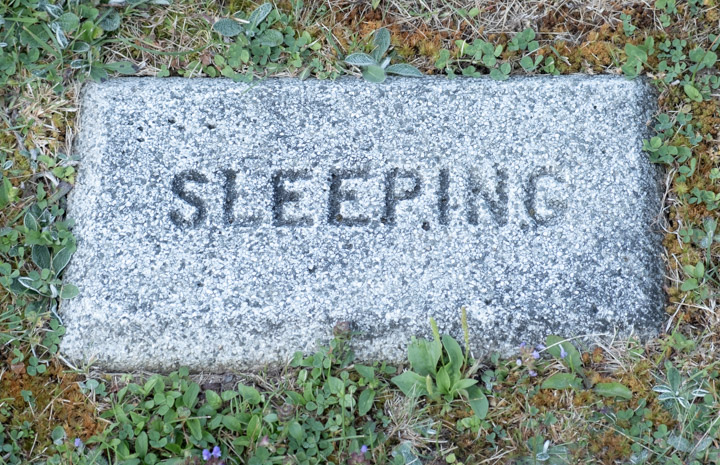
How long will it still matter that my hometown is one of the world’s youngest big cities?
Many graveyards are church attachments, but many more greet you at a random turn in the road; always framed by forest. The density of churches is remarkable; all built of wood, mostly white, mostly well-kept. This one was attached to the graves above and is untypically faded (but lovely inside).

Some of the churches have become boutiques and breweries, but those that haven’t still occur more densely than in any other New World jurisdiction I’ve seen. Why should faith hold stronger down East?
Another church, St Dunstan’s Basilica in Charlottetown, offered perhaps the most intense experience of the whole trip, because a singer and organist were practicing elaborate hymn treatments. Both were great, the organ is a magnificent Casavant, and parish organist Leo Marchildon was having fun, putting lots of wind through those pipes including the 32’ bass monsters. My ears and I were smiling when we left.

The stained glass is nothing special
but I liked the opened panes at the bottom.
Forts and cannons, I said; the Maritimes’ messy history included repeated captures and recaptures by the forces of France and Britain and the USA, and quite a few of the forts had been put to their intended use, repelling or falling to one invader or another.
The locals, at least the ones who set things up for tourists, seem to take their history seriously; I don’t pretend expertise or even much interest in it, but I have to say that some cannons have good typography.

“VR” is Victoria Regina of course,
so sometime in the second half of the 19th
century.
The colors are different, and an entry later in this series will dip in gleefully and give me a platform for camera geekery. One expects changes in houses and vegetation when you travel four timezones away, but nothing prepared me for the shockingly red soil in Prince Edward Island (hereinafter PEI).

Past Tignish at PEI’s northern extremity,
well off the paved-roads part.
I opened with words about everything facing the sea. Not entirely true, sometimes you’re looking at a lake.

Those kids don’t know how lucky they are.
This is in the wonderful Kejimkujik National Park in central Nova Scotia, mostly closed due to extreme wildfire peril.
All across the Maritimes, drought was in effect; crops failing, forest trails closed. Which reminds me; near that lake there was a birch-bark-canoe workshop. I asked the guy making the canoe how long it took. He said “My great-grandpa could do it in seven days, because back then there were birch trees big enough that you could make the whole hull out of a single piece.” It’s very difficult to find any aspect of life on earth that isn’t exhibiting Anthropocene damage.
Usually, it’s the sea that you’re looking at.


Above, coastline near Annapolis Royal.
Below, low tide near Chipman Brook.
From one end of Canada to the other; to me, the surprise was not so much the difference in the landscapes but the similarity of the people; they spoke my accent, shopped in my stores, obeyed my road signs. More on that later. For now, this.

On Bell Island, among the LaHaves.
RFC 9839 and Bad Unicode 14 Aug 2025, 7:00 pm
Unicode is good. If you’re designing a data structure or protocol that has text fields, they should contain Unicode characters encoded in UTF-8. There’s another question, though: “Which Unicode characters?” The answer is “Not all of them, please exclude some.”
This issue keeps coming up, so Paul Hoffman and I put together an individual-submission draft to the IETF and now (where by “now” I mean “two years later”) it’s been published as RFC 9839. It explains which characters are bad, and why, then offers three plausible less-bad subsets that you might want to use. Herewith a bit of background, but…
Please
If you’re actually working on something new that will have text fields, please read the RFC. It’s only ten pages long, and that’s with all the IETF boilerplate. It’s written specifically for software and networking people.
The smoking gun
The badness that 9839 focuses on is “problematic characters”, so let’s start with a painful example of what that means.
Suppose you’re designing a protocol that uses JSON and one of your constructs has a username field.
Suppose you get this message (I omit all the non-username fields). It’s
a perfectly legal JSON text:
{ "username": "\u0000\u0089\uDEAD\uD9BF\uDFFF" }
Unpacking all the JSON escaping gibberish reveals that the value of the username field contains four
numeric “code points” identifying Unicode characters:
The first code point is zero, in Unicode jargon
U+0000. In human-readable text it has no meaning, but it will interfere with the operation of certain programming languages.Next is Unicode
U+0089, official name “CHARACTER TABULATION WITH JUSTIFICATION”. It’s what Unicode calls a C1 control code, inherited from ISO/IEC 6429:1992, adopted from ECMA 48 (1991), which calls it “HTJ” and says: HTJ causes the contents of the active field (the field in the presentation component that contains the active presentation position) to be shifted forward so that it ends at the character position preceding the following character tabulation stop. The active presentation position is moved to that following character tabulation stop. The character positions which precede the beginning of the shifted string are put into the erased state.Good luck with that.
The third code point,
U+DEAD, in Unicode lingo, is an “unpaired surrogate”. To understand, you’d have to learn how Unicode’s much-detested UTF-16 encoding works. I recommend not bothering.All you need to know is that surrogates are only meaningful when they come in pairs in UTF-16 encoded text. There is effectively no such text on the wire and thus no excuse for tolerating surrogates in your data. In fact, the UTF-8 specification says that you mustn’t use UTF-8 to encode surrogates. But the real problem is that different libraries in different programming languages don’t always do the same things when they encounter this sort of fœtid interloper.
Finally,
\uD9BF\uDFFFis JSON for the code pointU+7FFFF. Unicode has a category called “noncharacter”, containing a few dozen code points that, for a variety of reasons, some good, don’t represent anything and must not be interchanged on the wire.U+7FFFFis one of those.
The four code points in the example are all clearly problematic. The just-arrived RFC 9839 formalizes the notion of “problematic” and offers easy-to-cite language saying which of these problematic types you want to exclude from your text fields. Which, if you’re going to use JSON, you should probably do.
Don’t blame Doug
Doug Crockford I mean, the inventor of JSON. If he (or I or really anyone careful) were inventing JSON now that Unicode is mature, he’d have been fussier about its character repertoire. Having said that, we’re stuck with JSON-as-it-is forever, so we need a good way to say which of the problematic characters we’re going to exclude even if JSON allows them.
PRECISion
You may find yourself wondering why the IETF waited until 2025 to provide help with Bad Unicode. It didn’t; here’s RFC 8264: PRECIS Framework: Preparation, Enforcement, and Comparison of Internationalized Strings in Application Protocols; the first PRECIS predecessor was published in 2002. 8264 is 43 pages long, containing a very thorough discussion of many more potential Bad Unicode issues than 9839 does.
Like 9839, PRECIS specifies subsets of the Unicode character repertoire and goes further, providing a mechanism for defining more.
Having said that, PRECIS doesn’t seem to be very widely used by people who are defining new data structures and protocols. My personal opinion is that there are two problems which make it hard to adopt. First, it’s large and complex, with many moving parts, and requires careful study to understand. Developers are (for good reason) lazy.
Second, using PRECIS ties you to a specific version of Unicode. In particular, it forbids the use of the (nearly a million) unassigned code points. Since each release of Unicode includes new code point assignments, that means that a sender and receiver need to agree on exactly which version of Unicode they’re both going to use if they want reliably interoperable behavior. This makes life difficult for anyone writing a general-purpose code designed to be used in lots of different applications.
I personally think that the only version of Unicode anybody wants to use is “as recent as possible”, so they can be confident of having all the latest emojis.
Anyhow, 9839 is simpler and dumber than PRECIS. But I think some people will find it useful and now the IETF agrees.
Source code
I’ve written a little Go-language library to validate incoming text fields against each of the three subsets that 9839 specifies, here. I don’t claim it’s optimal, but it is well-tested.
It doesn’t have a version number or release just yet, I’ll wait till a few folk have had a chance to spot any dumb mistakes I probably made.
Details
Here’s a compact summary of the world of problematic Unicode code points and data formats and standards.
| Problematic classes excluded? | |||
|---|---|---|---|
| Surrogates | Legacy controls | Noncharacters | |
| CBOR | yes | no | no |
| I-JSON | yes | no | yes |
| JSON | no | no | no |
| Protobufs | no | no | no |
| TOML | yes | no | no |
| XML | yes | partial [1] | partial [2] |
| YAML | yes | mostly [3] | partial [2] |
| RFC 9839 Subsets | |||
| Scalars | yes | no | no |
| XML | yes | partial | partial |
| Assignables | yes | yes | yes |
Notes:
[1] XML allows C1 controls.
[2] XML and YAML don’t exclude the noncharacters outside the Basic Multilingual Pane.
[3] YAML excludes all the legacy controls except for the mostly-harmless U+0085, another version of
\n used in IBM mainframe documents.
Thanks!
9839 is not a solo production. It received an extraordinary amount of discussion and improvement from a lot of smart and well-informed people and the published version, 15 draft revisions later, is immensely better than my initial draft. My sincere thanks go to my co-editor Paul Hoffman and to all those mentioned in the RFC’s “Acknowledgements” section.
On individual submissions
9839 is the second “individual submission” RFC I’ve pushed through the IETF (the other is RFC 7725, which registers the HTTP 451 status code). While it’s nice to decide something is worth standardizing and eventually have that happen, it’s really a lot of work. Some of that work is annoying.
I’ve been involved in other efforts as Working-Group member, WG chair, and WG specification editor, and I can report authoritatively that creating an RFC the traditional way, through a Working Group, is easier and better.
I feel discomfort advising others not to follow in my footsteps, but in this case I think it’s the right advice.
Long Links 4 Aug 2025, 7:00 pm
All of these Long Links pieces have begun with more or less the same words, so why stop now? This is an annotated parade of links to long-form pieces. Most people won’t have the time (nor the weird assortment of interests) to consume them all, but I hope that most readers will find one or two reward a visit.
Radisson (and Groseilliers)
I don’t know if it is still the case, but in my youth, Canadian elementary education included several overexcited units about the Coureurs des bois, early European settlers in “New France” (now Québec) who ventured, by foot and canoe, far to the north and west, mostly engaged in trading with the indigenous peoples: trinkets (and later, serious hardware including guns) for furs.
The names I remembered were Radisson and Groseilliers, but I don’t recall learning much about who they were and what they did. Then I ran across the 2019 book Bush Runner: The Adventures of Pierre-Esprit Radisson and, wow… The writing is pedestrian but who cares because what a story! Radisson lived an absolutely astonishing life. He went as deep into the bush as anyone of his era, interacted intensely with the indigenous people as business partner, friend, and foe, worked for Charles of England and Louis of France (changing sides several times), in 1670 founded the Hudson’s Bay Company (recently, 355 years later, deceased), and fortunately took notes, a copy of which was preserved by Samuel Pepys.
I learned more from this book’s pages about the early history of Upper and Lower Canada than all those elementary-school units had to offer, and had loads of fun doing so. I guess this is a fairly Canadian-specific Long Link, but I think anyone interested in the early history of Europeans in North America would find much to enjoy.
Music
It’s rare these days that I discover interesting new musicians, but here are two of those rarities.
Lucie Horsch plays recorder, you know, the cheap plastic thing they use to introduce second-graders to music. It’s actually a lovely instrument and I wish we would switch to its German name, “Blockflöte”, which to my ear sounds a bit like the instrument does. Anyhow, check out this YouTube entitled only Lucie Horsch - Bach, annoyingly omitting any mention of which Bach. Annoyance aside, it’s a pretty great performance, Ms Horsch is the real deal, full of virtuosity and grace.
I got an unusual mid-week message from Qobuz, all excited about The New Eves’ new record The New Eve Is Rising. So I played it in the car on a long crosstown drive and now I’m all excited too. The New Eves are talented, musically surprising, and above all, insanely brave.
Their music doesn’t sound like anything else and flies in the face of all conventional wisdom concerning popular music. They take absurd chances and yeah, the album has klunkers amid the bangers, but when I got to its end I went back and started at the beginning again. I found myself smiling ear-to-ear over and over. Maybe I’m being a bit over-the-top here, but check them out: Mother is live. Cow Song is off the new album and strong albeit with forgettable video.
Life online
Every Long Links has hardcore-geek threads and there is no harder core imaginable than Filippo Valsordi’s Go Assembly Mutation Testing. I have always admired (but never actually used) mutation testing, and Filippo offers a convincing argument that it moves catching certain classes of bug from nearly impossible to pretty easy. Good stuff!
And of course we can’t ignore genAI and programming. Most of you are likely aware of Measuring the Impact of Early-2025 AI on Experienced Open-Source Developer Productivity, but I’m linking again to boost its visibility, because hard quantitative research on methodology is damn rare in our profession. I will confess to being a little (but just a little) surprised at the conclusions.
It is apparently quite possible that Intel will exit the business of making high-end chips, leaving TSMC with a global monopoly: Intel and the Wide Open Barn Doors. This is an unsettling prospect. Not, I have to say, surprising though. I’ve sneered at Intel leadership cluelessness for years and years, see here and here.
Finally, here’s the charmingly-titled How to Surf the Web in 2025, and Why You Should. I love this piece.
Class Reductionism
The news keeps making me want to build something around the classreductionist.org domain name I’ve owned for
years.
The tl;dr on Class Reductionism is something like “In the best possible world it’ll take generations to disassemble the global tangle of intersectional oppression, but we could treat the symptoms effectively right now this year by sending money to the poor. I’m talking about Universal Basic Income or suchlike. I wrote a couple thousand words on the subject back in 2023, and there are complexities, and I probably won’t put up that site. But I still do maintain that a very high proportion of our societal pain is rooted in the egregious inequality, and consequent poverty, that seems a baked-in feature of Late Capitalism.
Let’s start with Nobelist Paul Krugman, who’s been writing an “Understanding Inequality” series on his paywalled newsletter and then republishing a gratis version, start here. Very data-dense and educational. Hmm, that site is slow; there’s a livelier table of contents here.
Don’t kid yourself that this is just an American problem, see ‘The Better Life Is Out of Reach’: The Chinese Dream Is Slipping Away.
Let’s pull the impersonal veil of facts and figures aside and focus on the human experience of what we used to call Class Struggle. Confessions of the Working Poor is beautifully written and opened my eyes to lifestyle choices that I didn’t even know some people have to make.
But hey, there are people who are just fine with this: Delta's premium play is taking advantage of the growing economic split.
Look, being class-determinist-adjacent doesn’t mean you should ignore intersectional awfulness: What We Miss When We Talk About the Racial Wealth Gap.
No more sections
The remaining Long Links refused to be organized so I had to turn them loose; call it the Long Tail.
The Venetian origins of roman type. You might think you don’t care about typography but still enjoy the pictures and descriptions here.
This guy is a full-time Coyote researcher. What a great gig! I’m an admirer of those animals and how they’ve carved themselves a comfy niche in most of North America’s big cities. (Even if it means that you better not let your cat out at night.) They’re also remarkably attractive.
Here’s another long list of Long Links, and many of you will wonder why anyone would choose to browse it: The Best Camera Stores in Tokyo: The Ultimate Guide. Some of the interiors are remarkable.
Oh, while we’re on the subject of photography: A Photojournalist Took a Fujifilm Instax Camera to a Mexican Cartel Wedding.
GLP-1’s (i.e. Ozempic and friends) would probably dominate a large section of the news if weren’t for all the political craziness. Here’s one small example: How GLP-1s Are Breaking Life Insurance.
Science is hard. There are lots of largely-unsolved areas, and “gap-map.org” tries to organize them: Fundamental Development Gap Map v1.0. The UI is a little klunky but the thing still sucked me right in.
I’m going to give the last word to Laurie Penny. I don’t know what we’d do without her. In a time of monsters: do we have any ideas for surviving the zombie apocalypse that aren’t nightmare patriarchy?
Page processed in 0.667 seconds.
Powered by SimplePie 1.4-dev, Build 20170403172323. Run the SimplePie Compatibility Test. SimplePie is © 2004–2025, Ryan Parman and Geoffrey Sneddon, and licensed under the BSD License.
